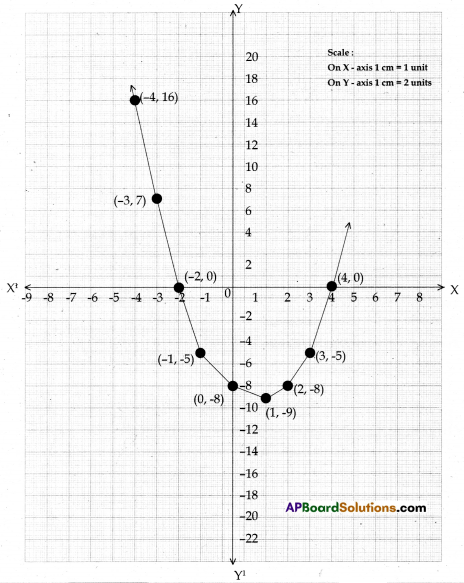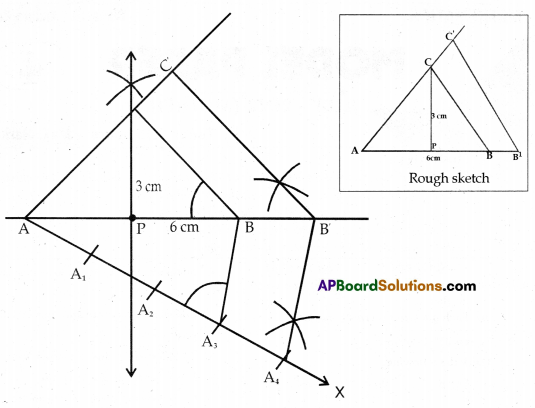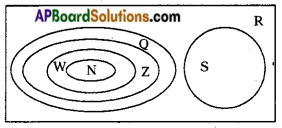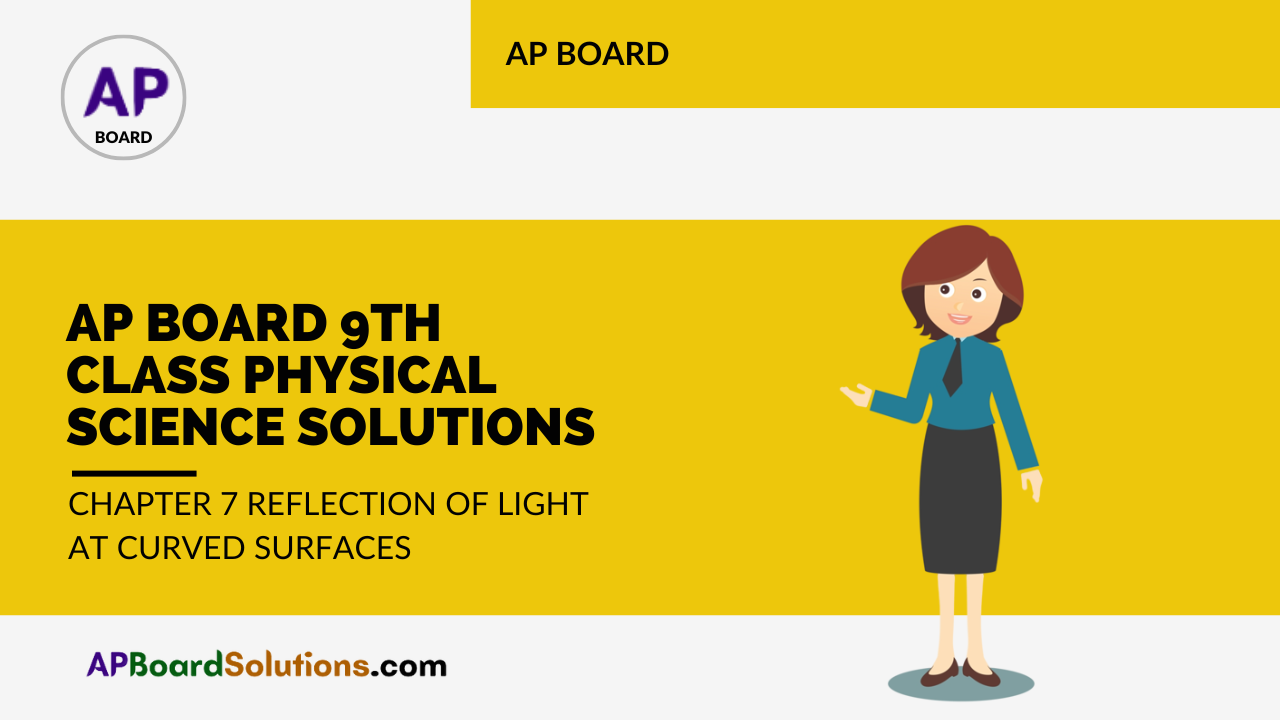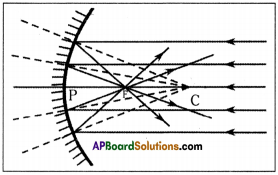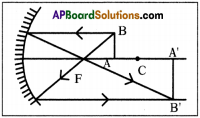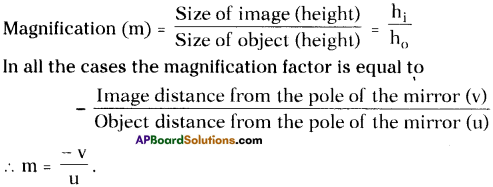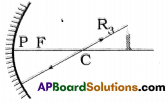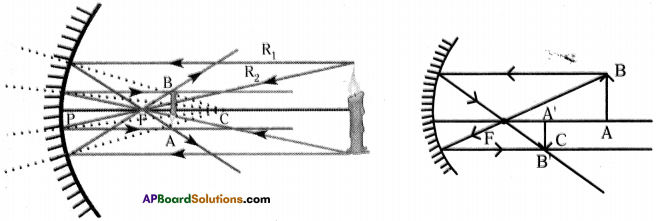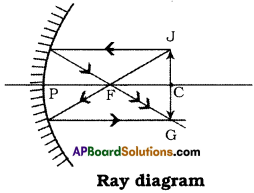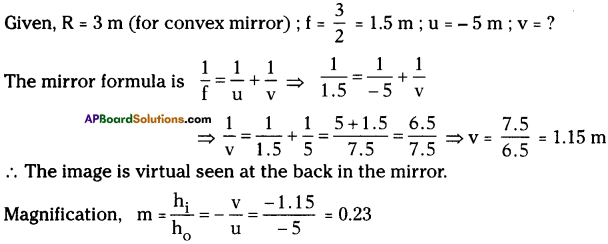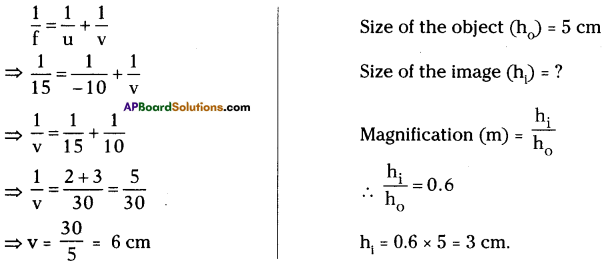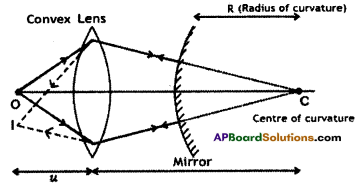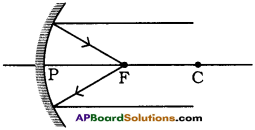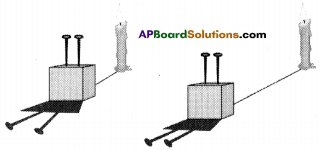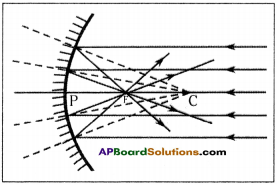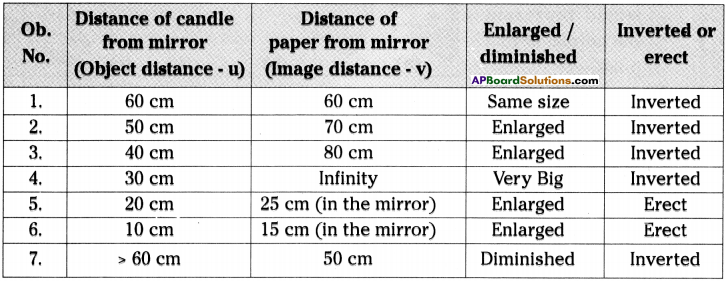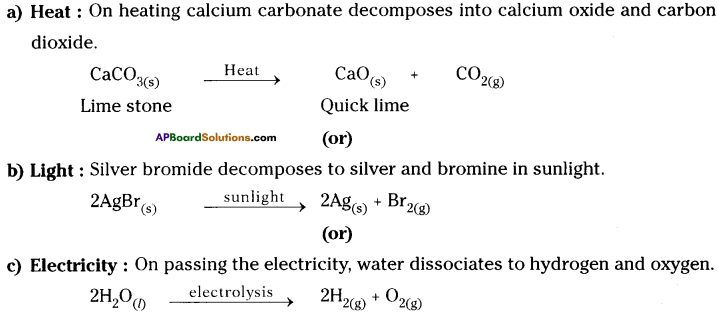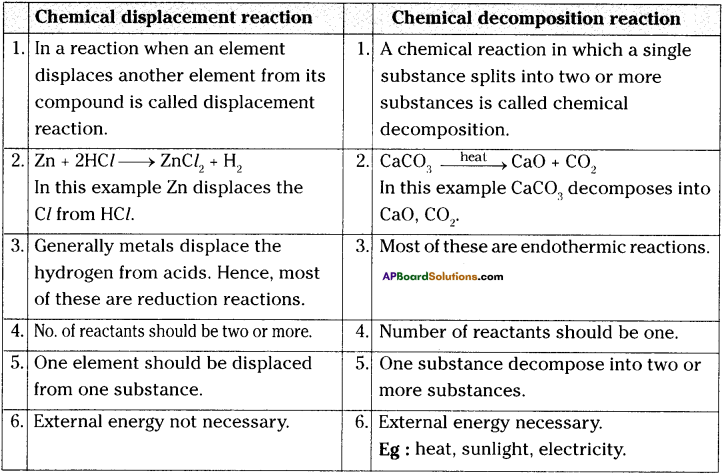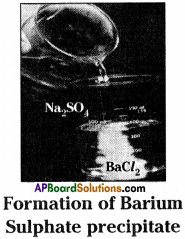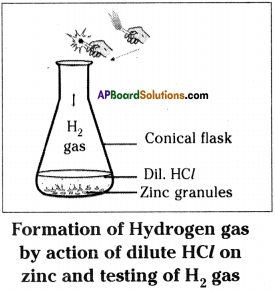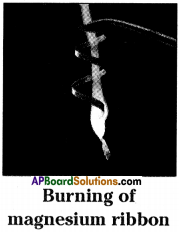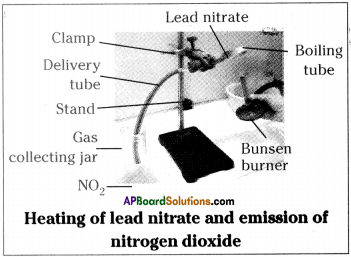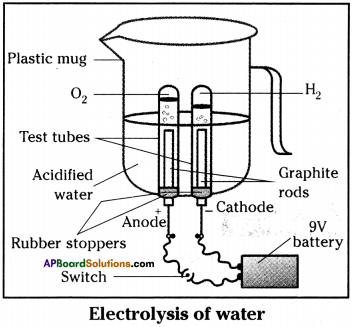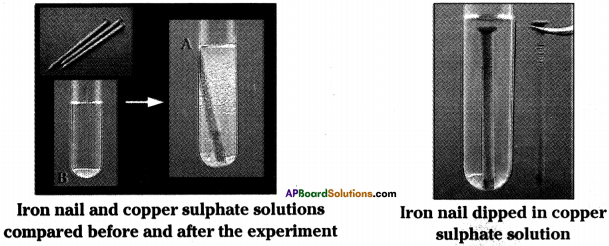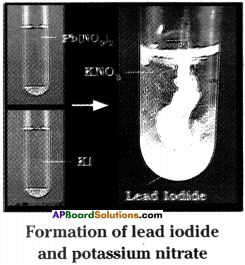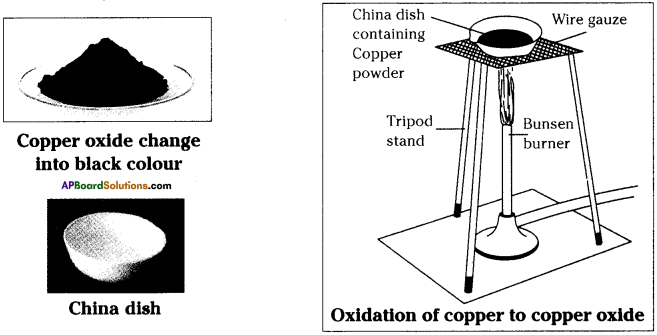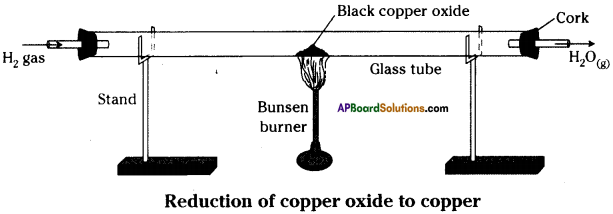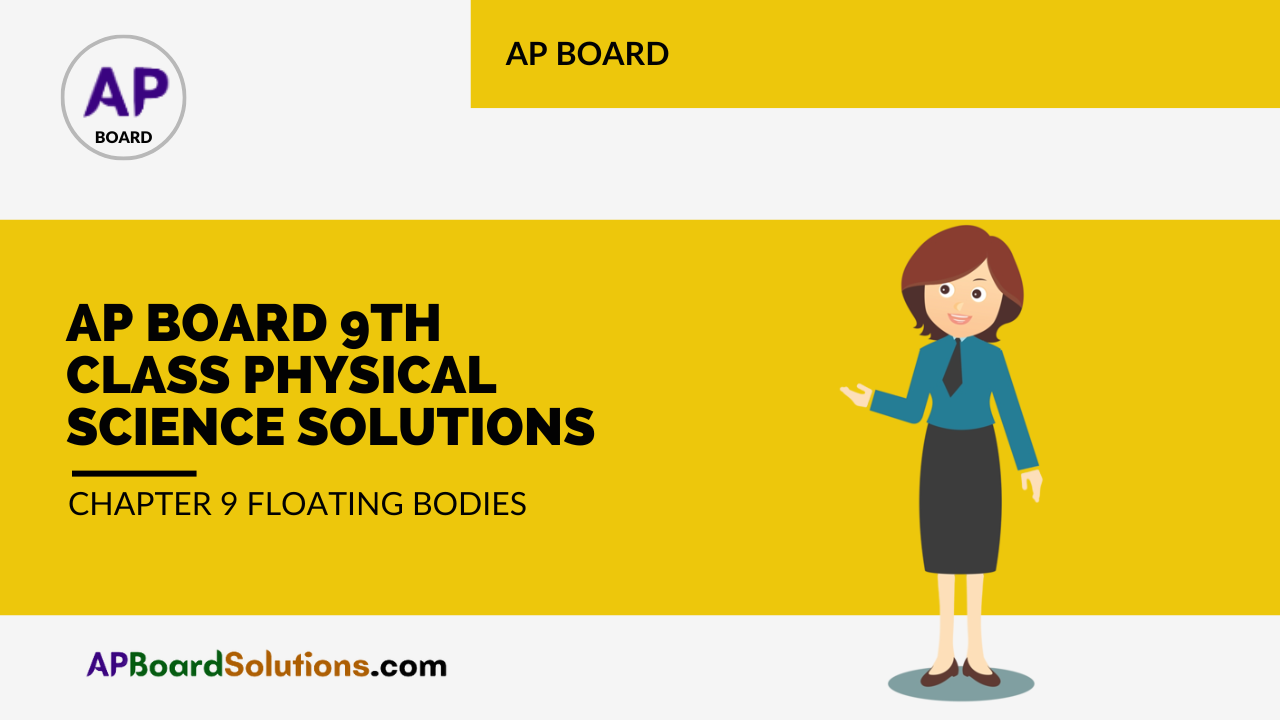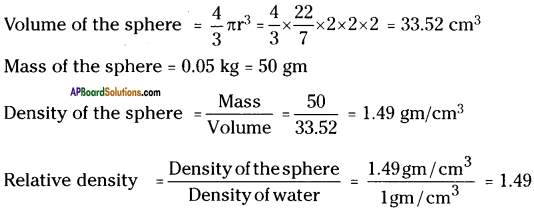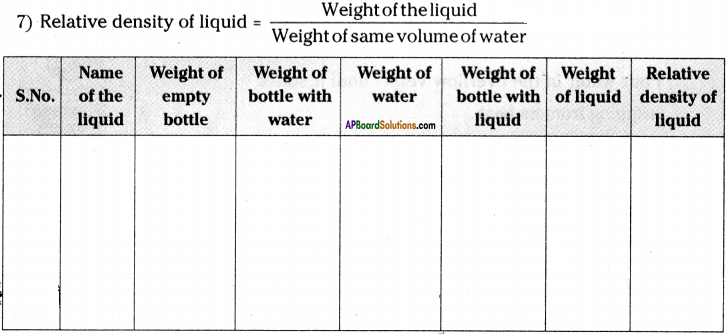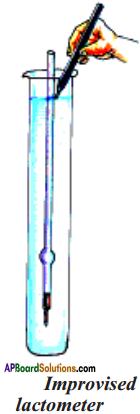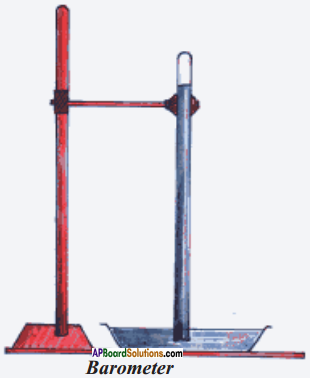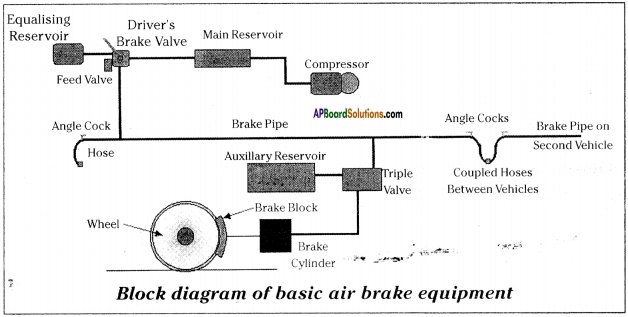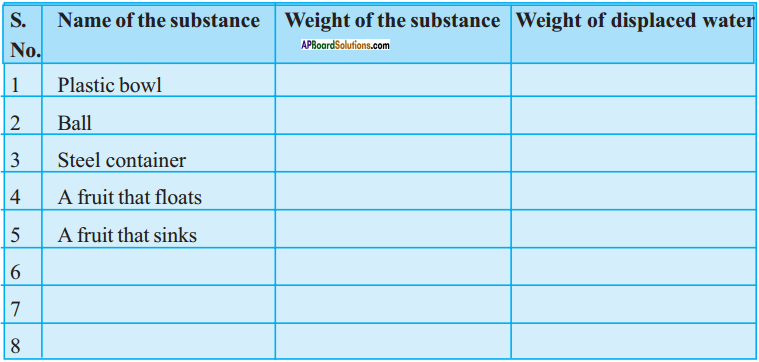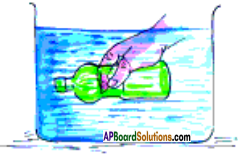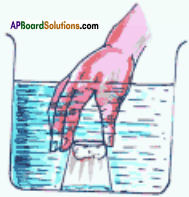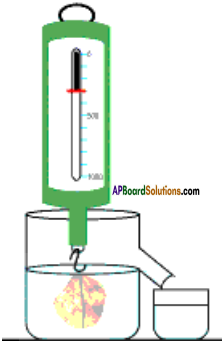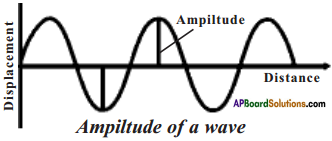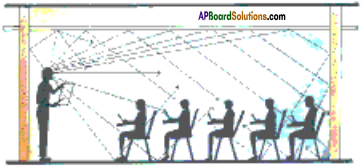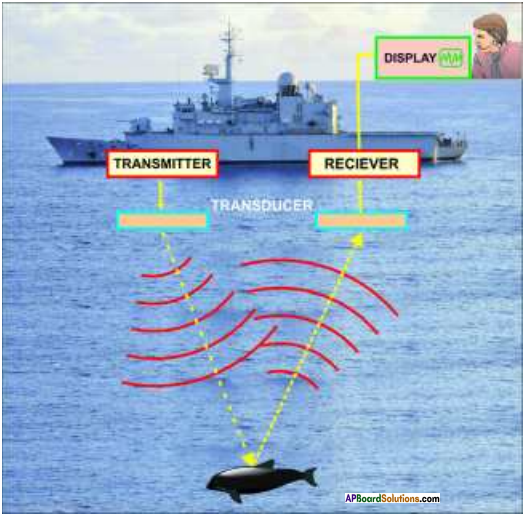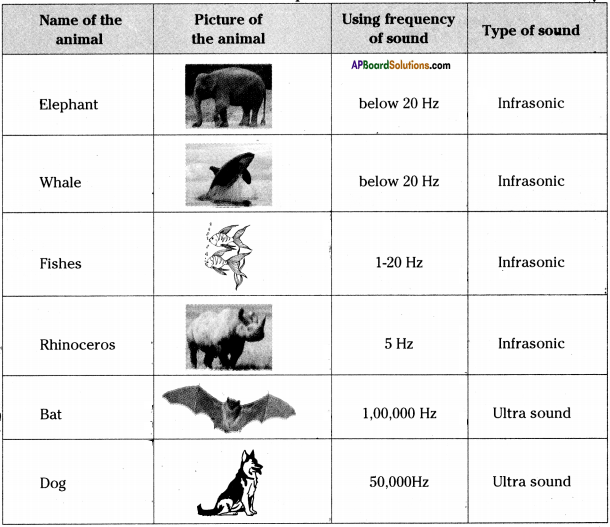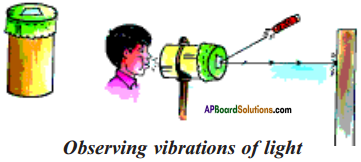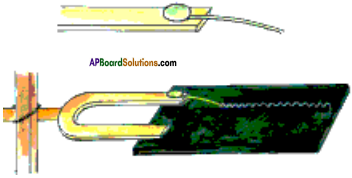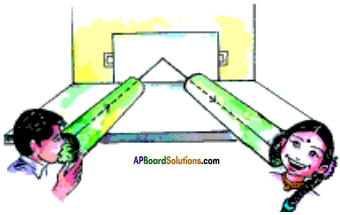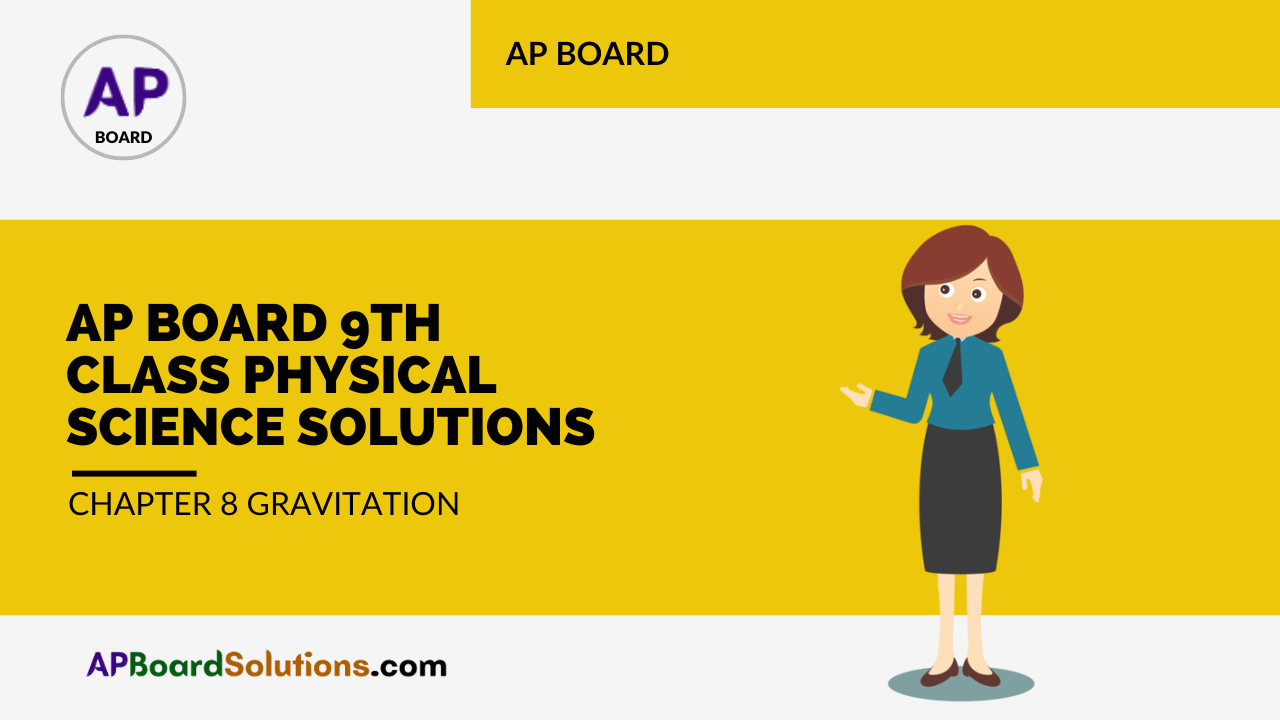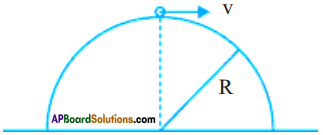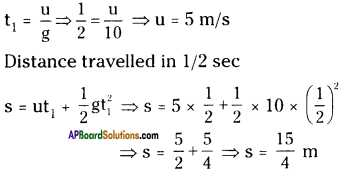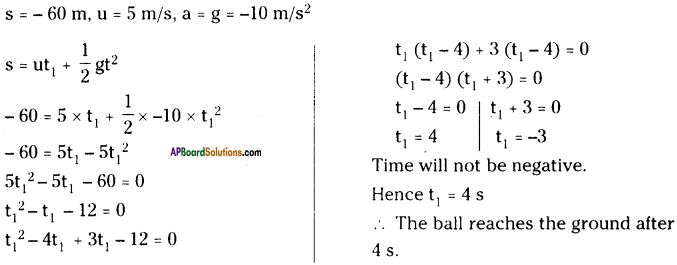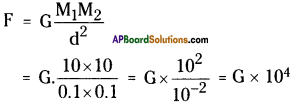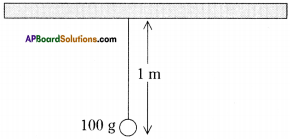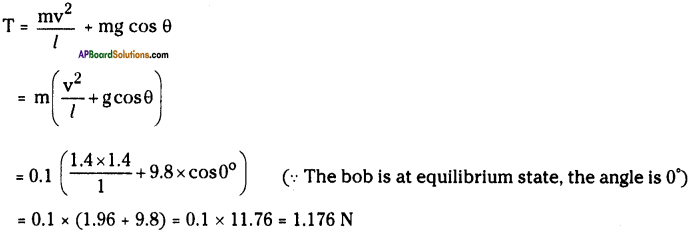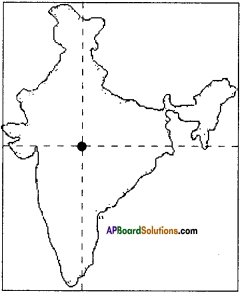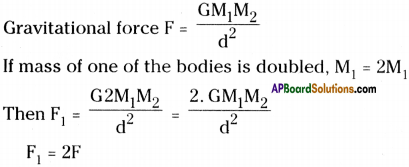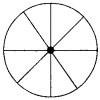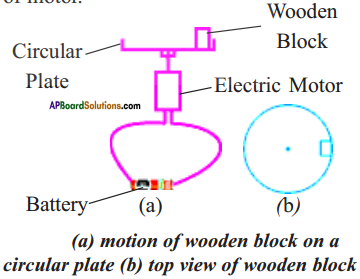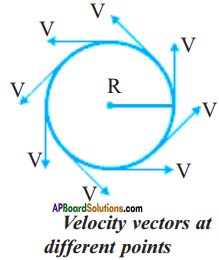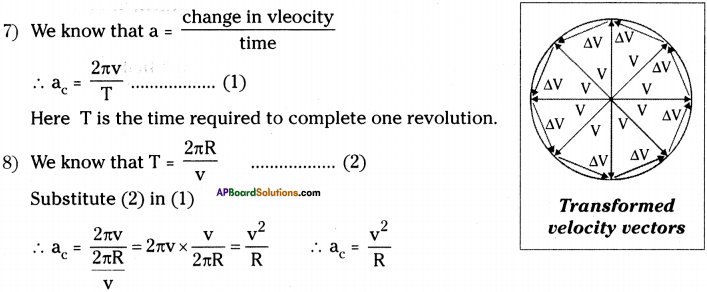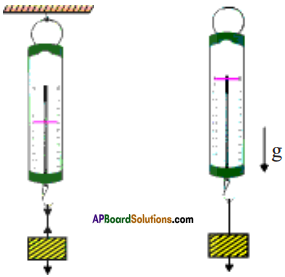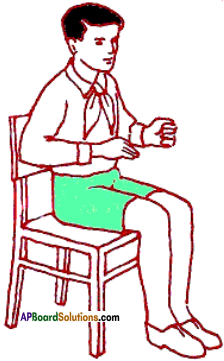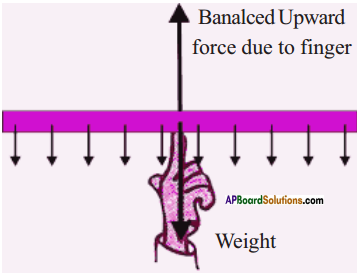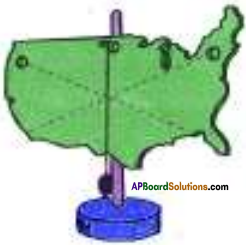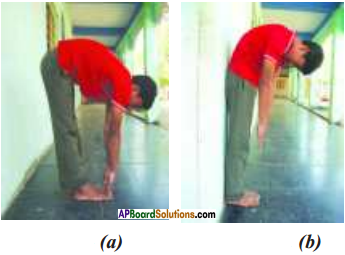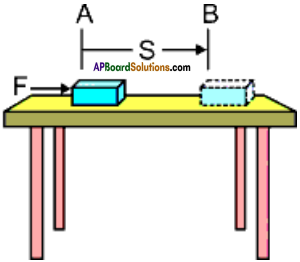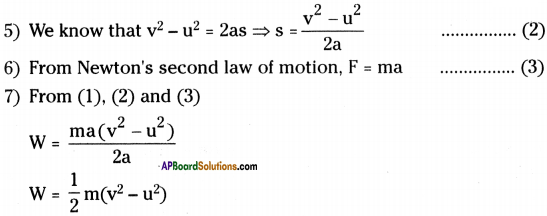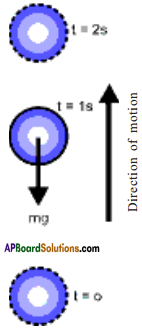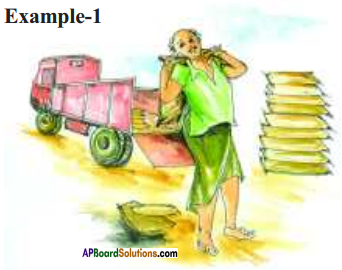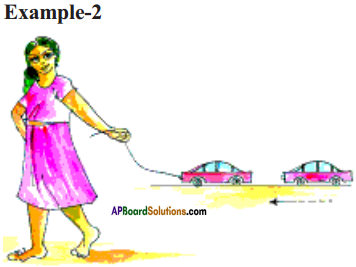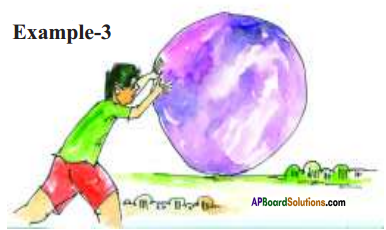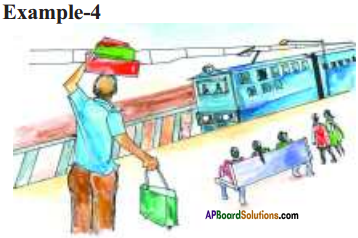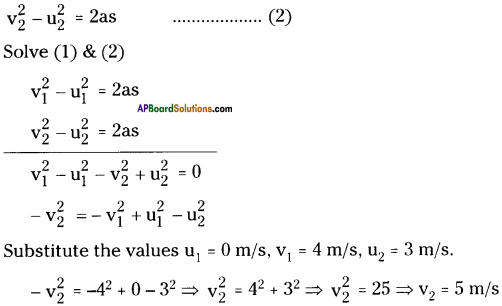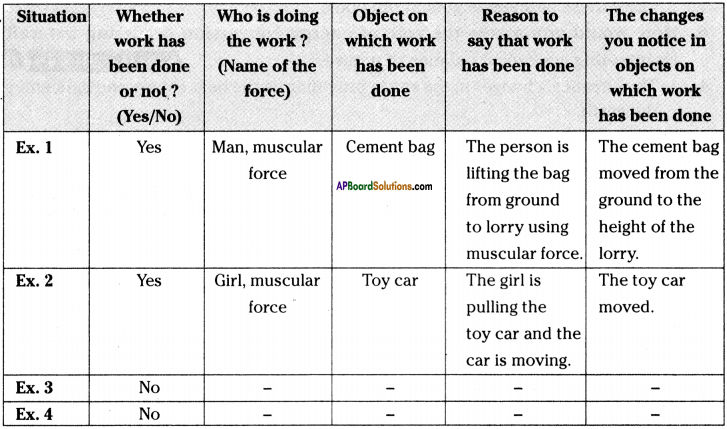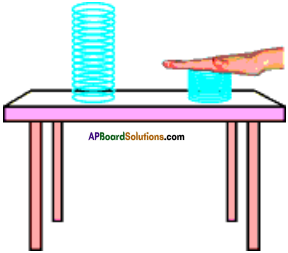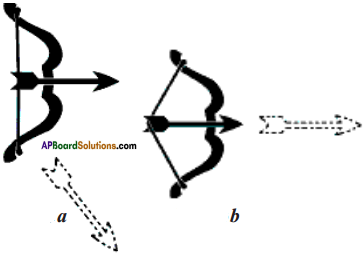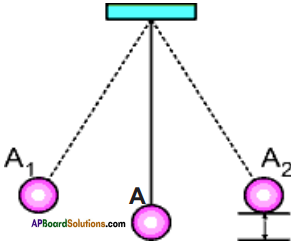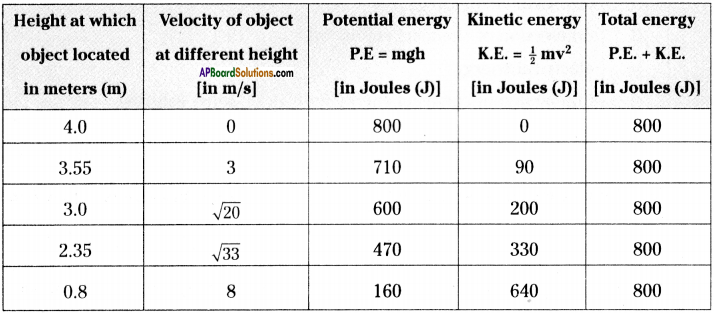AP State Board Syllabus AP SSC 10th Class Telugu Solutions 1st Lesson మాతృభావన Textbook Questions and Answers.
AP State Syllabus SSC 10th Class Telugu Solutions 1st Lesson మాతృభావన
10th Class Telugu 1st Lesson మాతృభావన Textbook Questions and Answers
ఉన్ముఖీకరణ : చదవండి – ఆలోచించి చెప్పండి
తే. సర్వతీర్ధాంబువులకంటె సమధికంబు
పావనంబైన జనయిత్రి పాదజలము
వరతనూజున కఖిలదేవతల కంటె
జనని యెక్కుడు సన్నుతాచారనిరత
ప్రశ్నలు – జవాబులు
ప్రశ్న1.
“పావనంబైన జనయిత్రి పాదజలము” అంటే ఏమిటి?
జవాబు:
జనయిత్రి అంటే తల్లి. జన్మనిచ్చిన తల్లి సర్వదేవతల కంటే ఎక్కువ. అటువంటి తల్లి యొక్క పాదాలు కడిగిన నీరు చాలా పవిత్రమైనది. విష్ణువు పాదాల నుండి జన్మించింది గంగ. అది ఎంతో పవిత్రమైంది. అటువంటి పవిత్రత కలిగిందే తల్లి పాదాలు కడిగిన నీరు.
ప్రశ్న2.
తల్లి పాదజలం దేనికంటే గొప్పదని తెలుసుకొన్నారు? ఎందువల్ల?
జవాబు:
తల్లి పాదజలం అన్ని తీర్థాలలోని (పుణ్యనదులలోని) నీటి కంటే పవిత్రమైనదని తెలుసుకొన్నాం. ఆ నదులలోని నీరు ఆ నదీ తీరాలలోని దైవం లేదా దైవాల పాదాలకు తగలడం వల్ల అవి పవిత్రమై పుణ్యనదులుగా లెక్కింపబడతాయి. కానీ, తల్లి సమస్త దేవతల కంటే ఎక్కువ కనుక తల్లి పాదాలు కడిగిన నీరు పుణ్యనదీ జలం కంటే గొప్పది.

ప్రశ్న3.
కుమారునికి అన్నింటికంటే ఎవరు మిన్న? ఎందుకు?
జవాబు:
కుమారునికి అంటే సంతానమందరికీ అన్నింటికంటే తల్లి యొక్క పాదాలు కడిగిన నీరు పరమ పవిత్రమైనది. ఎందుకంటే తన కడుపులో 9 నెలలు మోసి, కని, పెంచి, పోషిస్తూ, రక్షించే తల్లి దైవం కంటే గొప్పది. దైవం కనబడడు. తల్లి కనబడే దైవం. అటువంటి తల్లి యొక్క పాదాలు కడిగిన నీరు దేవుడికి అభిషేకం చేసిన నీటికంటే పవిత్రమైనది.
ప్రశ్న4.
ఈ పద్యం ద్వారా తల్లికి గల స్థానమేమిటని గ్రహించారు?
జవాబు:
మన సంప్రదాయం, మన సంస్కృతి తల్లికి అత్యున్నత స్థానమిచ్చింది. ఈ పద్యం కూడా తల్లి యొక్క మహోన్నత స్థానం గుర్తుచేసింది. ‘మాతృదేవోభవ, పితృదేవోభవ, ఆచార్యదేవోభవ…….’ అని ఉపనిషత్తులు కూడా తల్లికి మొదటిస్థానం ఇచ్చాయి. దైవం కంటే గొప్పదైన తల్లికి నమస్కరించాలి. ఆమె పాదజలం సంతానానికి శిరోధార్యం అని ఈ పద్యం ద్వారా గ్రహించాము.
ప్రశ్న5.
“ప్రతి స్త్రీమూర్తీ మనకు తల్లితో సమానం” అని ఎందుకంటారు?
జవాబు:
స్త్రీ లేకపోతే సృష్టి లేదు. భగవంతుడు అందరి వద్దా ఉండలేడు కనుక తనకు మారుగా తల్లిని సృష్టించాడు. ప్రతి స్త్రీలోనూ తన తల్లిని చూసుకోగలిగినవాడే మహాత్ముడు. రామకృష్ణ పరమహంస తన భార్య శారదాదేవిలో కూడా తన తల్లిని, జగన్మాతను సందర్శించి పూజించాడు. అందుచేత ప్రతి స్త్రీని తల్లిలాగా చూడాలి. గౌరవించాలి. ఆదరించాలి.
ఆలోచించి చెప్పండి
ప్రశ్న1.
‘విజయగర్వంతో నీవు చేసిన పని సరికాదని’ అనే మాటలనుబట్టి శివాజీ ఎలాంటివాడని భావిస్తున్నారు?
జవాబు:
గర్వం ప్రమాదకరం. విజయగర్వం మరీ ప్రమాదకరం. విజయం వచ్చినపుడు చాలా జాగ్రత్తగా ఉండాలి. లేకపోతే ఆ విజయగర్వంతో చాలా తప్పులు చేసే అవకాశం ఉంది. కనుక శివాజీది ఎదిగే కొద్దీ ఒదిగి ఉండే స్వభావం అని తెలిసింది. విజయం సాధించిన ప్రతిసారీ ఆత్మవిమర్శ చేసుకొనేవాడు. వినయం పెంచుకొనేవాడు. శివాజీ గర్వం లేని వీరుడు.
ప్రశ్న2.
స్త్రీలపట్ల మర్యాదగా ప్రవర్తించడం అంటే ఏమిటి?
జవాబు:
స్త్రీలు శారీరకంగా, మానసికంగా సున్నితంగా ఉంటారు. వారి మనసు బాధపడేలా మాట్లాడకూడదు. కించపరచ కూడదు. వెకిలిగా ప్రవర్తించకూడదు. వారికి చట్టపరంగా సంక్రమించవలసిన హక్కులను పొందేలా చూడడం, సహాయం చేయడం, మన తల్లి, సోదరి పట్ల ఎలా ప్రవర్తిస్తామో ప్రతి స్త్రీ పట్ల అలా ప్రవర్తించడం మర్యాద.
ప్రశ్న3.
శివాజీ కోపానికి కారణమేమిటి ? కోపంలో శివాజీ ఎలా ఉన్నాడు?
జవాబు:
ఓడిపోయిన వీరుని సో దేవుడు బంధించి తెచ్చాడు. అతనితో బాటు అతని రాణివాసాన్ని కూడా బంధించి తెచ్చాడు. రాణివాసాన్ని బంధించి తేవడమే శివాజీ కోపానికి కారణమైంది.
కోపంలో శివాజీకి కళ్లు ఎఱ్ఱబడ్డాయి. పెదవులు అదిరాయి. బొమముడి కదుల్తోంది. హుంకరిస్తున్నాడు. గర్జిస్తున్నాడు. శివాజీని చూడడానికి కూడా రాజసభ జంకింది. అంటే ప్రళయకాల రుద్రుడిలా ఉన్నాడు శివాజీ.
ప్రశ్న4.
“సరభసోత్సాహంబు కన్జప్పె” అంటే మీకేమర్థమైంది?
జవాబు:
సరభస ఉత్సాహము అంటే ఉవ్విళ్ళూరు ఉత్సాహం. అంటే ఒక విజయం సాధించినపుడు చాలా ఉత్సాహం వస్తుంది. కన్దప్పడము అంటే ఆ ఉత్సాహంలో సాధించిన విజయం తప్ప కళ్లకు ఏదీ కనబడదు. అంటే ఇతరుల బాధలు కానీ, తప్పులు కానీ, భయాలు కానీ, ఏవీ కళ్లకు కనబడవు- ఆ విజయం తప్ప.
ఆలోచించి చెప్పండి
ప్రశ్న1.
స్త్రీలను ఎవరితో పోల్చారు? ఎందుకు?
జవాబు:
స్త్రీలను సీత, సావిత్రి, అనసూయ, సుమతి మొదలైన పతివ్రతలతో పోల్చారు. స్త్రీలను దేవతావృక్షాలతో పోల్చారు. పతివ్రతా స్త్రీలు అగ్నిజ్వాలల వంటి వారన్నారు. ఎందుకంటే – రాముడు అగ్నిపరీక్ష చేశాడు. సీతాదేవి ఆ అగ్నిని పూలరాశిగా భావించింది. సీత యొక్క పవిత్రతకు అగ్ని కూడా చల్లబడింది. అంతటి మహాపతివ్రత సీత.
యమధర్మరాజును ప్రార్థించి, పోరాడి, మెప్పించి, తన భర్త సత్యవంతుని ప్రాణాలు తిరిగి తెచ్చింది సావిత్రి. యమధర్మాన్ని కూడా తన పాతివ్రత్య మహిమతో మార్చి తన భర్తను బ్రతికించుకొంది.
బ్రహ్మ, విష్ణు, మహేశ్వరులను పసిపిల్లలుగా మార్చి జోలపాడింది అనసూయ. ఈమె అత్రి మహాముని భార్య.
సూర్యోదయం అయితే భర్త మరణిస్తాడని, భర్తకు మరణం రాకుంటకు సూర్యోదయాన్ని ఆపిన మహా పతివ్రత సుమతి.
దేవతావృక్షాలు కోరిన కోరికలు తీరుస్తాయి. అవి ఉన్నచోట అశాంతి, అనారోగ్యం, ముసలితనం వంటి బాధలు ఉండవు. స్త్రీలు ఉన్న ఇల్లు కళకళలాడుతుంది. అశాంతికి అవకాశం లేదు.

ప్రశ్న2.
స్త్రీల పట్ల సమాజంలో ఎలాంటి అభిప్రాయాలు ఉన్నాయి? దీనిపై మీ అభిప్రాయాలు తెల్పండి.
జవాబు:
స్త్రీల పట్ల సమాజంలో గౌరవ భావమే ఉన్నది. కానీ,
సమాజంలో కొంతమంది స్త్రీలను చులకనగా చూస్తారు. చదువుకోనివారు, వివేకం లేనివారు, గౌరవం లేనివారు మాత్రమే స్త్రీలను తక్కువగా చూసే ప్రయత్నం చేస్తారు. స్త్రీలు బలహీనులనే భావం కూడా కొంతమందికి ఉంది. అది తప్పు.
ప్రశ్న3.
స్త్రీల వల్ల భారత కీర్తి ప్రతిష్ఠలు పెరుగుతున్నాయనడానికి ఉదాహరణలు తెల్పండి.
జవాబు:
స్త్రీల వలన ఏ దేశపు కీర్తి ప్రతిష్ఠలైనా పెరుగుతాయి. మన భారతదేశ స్త్రీలు అన్ని రంగాలలోనూ మగవారితో సమానంగా ఉన్నారు. యుద్ధరంగంలో రుద్రమదేవి, ఝాన్సీ లక్ష్మీబాయి, చాంద్ బీబీ మొదలైనవారు శత్రువులను గడగడలాడించారు.
రాజకీయ రంగంలో ఇందిరాగాంధీ, మీరాకుమార్, షీలాదీక్షిత్ మొదలైనవారు ధ్రువతారలు. రచనారంగంలో మొల్ల, రంగాజమ్మ మొదలైనవారు కావ్యాలు రాశారు.
మాలతీ చందూర్, యద్దనపూడి సులోచనారాణి, కోడూరి కౌసల్యాదేవి మొదలైనవారు నవలా రచయిత్రులుగా ఖ్యాతి గడించారు.
పి.టి. ఉష, అశ్వనీ నాచప్ప, కుంజరాణి, మిథాలీ రాజ్, కరణం మల్లీశ్వరి మొదలైనవారు క్రీడారంగంలో మణిపూసలు.
కస్తూరిబా గాంధీ, సరోజినీనాయుడు, దుర్గాబాయ్ దేశ్ ముఖ్ మొదలైనవారు స్వాతంత్ర్యోద్యమంలో పాల్గొన్నారు.
ప్రశ్న4.
“అనలజ్యోతుల………. సాగునే? ” అనే పద్యం ద్వారా మీకేమర్థమైంది?
జవాబు:
అగ్ని వంటి తేజస్సు కలవారు పతివ్రతలు, అంటే పుణ్యస్త్రీలు. తప్పుడు ఆలోచనలతో వారిని సమీపించడం కూడా తప్పు. అలా చేస్తే ఎంత గొప్పవారికైనా మరణం తప్పదు. నాశనం తప్పదు. వారి వంశం కూడా నిలబడదు.
రావణాసురుడు మహాభక్తుడు. గొప్ప పండితుడు. మహా బలవంతుడు, కానీ, సీతాదేవిని ఎత్తుకొని వచ్చాడు. తనను పెళ్ళి చేసుకోమని బాధించాడు. దాని ఫలితంగా రాముని చేతిలో మరణించాడు. యుద్ధంలో బంధువులు, స్నేహితులు అందరూ మరణించారు.
అంటే ఎంత గొప్పవారైనా స్త్రీని అవమానపరిస్తే నాశనం తప్పదని తెలిసింది.
ఆలోచించి చెప్పండి
ప్రశ్న1.
తల్లిగా గౌరవించడం అంటే ఏమిటి? ఆ ప్రవర్తన ఎలా ఉంటుంది?
జవాబు:
తల్లిని మించిన దైవం లేదు. తల్లి ప్రత్యక్ష దైవం. తొమ్మిది నెలలు కడుపులో పెట్టుకొని మోసి, కని, పెంచిన తల్లిని ఎంతగా గౌరవించినా తక్కువే. తల్లితో సమానంగా ప్రతి స్త్రీని గౌరవించాలి. ప్రతి స్త్రీలోనూ అమ్మను చూడాలి. అమ్మలోని కారుణ్యం చూడాలి. అదే, తల్లిగా గౌరవించడ
మంటే.
ప్రశ్న2.
సన్మార్గంలో నడవడం అంటే ఏమిటి? విద్యార్థులుగా మీరు చేయాల్సిన కొన్ని పనులను తెల్పండి.
జవాబు:
సన్మార్గం అంటే మంచి మార్గం. సన్మార్గంలో నడవడ మంటే చక్కని ప్రవర్తన కలిగి ఉండడం. “సాధించ వలసిన లక్ష్యమే కాదు. దానిని సాధించే మార్గం కూడా మంచిది కావాలి” అన్నాడు గాంధీజీ.. విద్యార్థులు మంచి ప్రవర్తన కలిగి ఉండాలి. సంఘంలో చాలా చెడులు ఉన్నాయి. వాటిని సంస్కరించాలి. ప్రజలను చైతన్యపరచాలి.
చదువురాని వారికి చదవటం, రాయడం నేర్పాలి. సమాజంలో జరిగే అనేక మోసాలను గూర్చి చెప్పాలి. మన చట్టాలపై అవగాహన కల్గించాలి.
వరకట్నం ఇవ్వడం, తీసుకోవడం తప్పని చెప్పాలి. ఆరోగ్యకరమైన అలవాట్లు నేర్పాలి. పరిశుభ్రత నేర్పాలి. మన గ్రామ, రాష్ట్ర, దేశ, అంతర్జాతీయ సమస్యలపై
అవగాహన కల్గించాలి. ఓటుహక్కు వినియోగం చెప్పాలి.

ప్రశ్న3.
“స్త్రీ రత్నముల్ పూజ్య, లేయవమానంబు ఘటింపరాదు,” అంటే ఏమిటి ?
జవాబు:
స్త్రీలు గౌరవింపదగినవారు. పూజింపతగినవారు. వారికి ఏ అవమానం జరగకూడదు. స్త్రీలను గౌరవించడం మన సంస్కారం. అది మన సంస్కృతి. అది మన విధి. వారిని మన మాటలతో గాని, ప్రవర్తనతో గాని బాధ పెట్టకూడదు.
ప్రశ్న4.
“హితసూక్తిన్ బల్కి” అంటే ఏమిటి?
జవాబు:
సు + ఉక్తి – సూక్తి అంటే మంచి మాట. హితసూక్తి అంటే ఇష్టాన్ని కలిగించే మంచి మాట. అంటే మంచి మాట అయినా ఇతరులు బాధ పడేలాగా చెప్పకూడదు. వినేవారికి సంతోషం కలగాలి. శివాజీ స్త్రీని గౌరవించాడు. సత్కరించాడు. తన వారు చేసిన తప్పును క్షమించ మన్నాడు. శత్రువీరుడిని విడిచిపెట్టాడు. అపుడు ‘హితసూక్తి’ చెప్పాడు.
I. అవగాహన – ప్రతిస్పందన
1. కింది అంశాల గురించి చర్చించండి.
అ) “ప్రస్తుతం స్త్రీలపై జరిగే దాడులకు కారణాలు – నివారణోపాయాలు”
జవాబు:
కారణాలు:
ప్రస్తుత సమాజంలో గురువుల పట్ల, పెద్దలపట్ల, తల్లిదండ్రుల పట్ల గౌరవ భావన తగ్గుతోంది. కారణాలు ఏమైనా కావచ్చును. నైతికత కూడా లోపించింది. దైవభక్తి తగ్గింది. ‘పాపం’ అనే భావన, భయం తగ్గింది. స్త్రీల పట్ల, బలహీనుల పట్ల, వృద్ధుల పట్ల బాధ్యత తగింది. దీనికి కారణం ప్రధానంగా సినిమాలు. సినిమాలలో, టి.వీ సీరియళ్ళలో స్త్రీలను అసభ్యకరంగా, కేవలం విలాసవస్తువుగా చూపిస్తున్నారు. ప్రేమికులు విచ్చలవిడిగా ప్రవర్తిస్తున్నారు. చెడు వ్యసనాలు కూడా మితిమీరి పోయాయి. రెచ్చగొట్టే ప్రవర్తనలు కూడా కారణం. మానవుని ఆలోచనా విధానం మారిపోయింది. చట్టాలన్నా కొందరికి భయం లేదు. అందుచేతనే స్త్రీలపై దాడులు పెరుగుతున్నాయి.
నివారణోపాయాలు :
చలనచిత్రాలలో స్త్రీని ఉన్నతంగా చూపించాలి. సాహిత్యంలో కూడా స్త్రీలను అంగాంగ వర్ణన చేయకూడదు. స్త్రీల పట్ల గౌరవం పెరిగే పాఠ్యాంశాలు పెట్టాలి. ఎవరైనా స్త్రీని కించపరుస్తున్నా, అవమానిస్తున్నా చూసీ చూడనట్లు వదలకూడదు. పిల్లలకు చిన్నతనం నుంచీ మంచి మంచి కథలు చెప్పాలి. స్త్రీని మాతృమూర్తిగా చూసే భావన పెంపొందాలి. ప్రేమికులు బహిరంగ ప్రదర్శనలు మానాలి. దుర్వ్యసనాలు నిరోధించాలి. సమాజాన్ని చైతన్యపరచాలి. స్త్రీ విద్యను ప్రోత్సహించాలి. సమాజంలో సంస్కారం, నీతి పెంచాలి. స్త్రీలకు రక్షణ పెంచాలి. చట్టాలు కచ్చితంగా అమలుచేయాలి. విదేశీ విజ్ఞానం ఆర్జించాలి గాని విదేశీ సంస్కృతి, అలంకరణలు కాదు. స్త్రీలు కూడా తగిన జాగ్రత్తలు పాటించాలి. ధైర్యం పెంచుకోవాలి. ఒంటరిగా తిరగకూడదు.

ఆ) “కుటుంబం – సమాజం అభివృద్ధిలో స్త్రీల పాత్ర”
జవాబు:
వ్యక్తులు లేనిదే కుటుంబం లేదు. కుటుంబాలు లేనిదే సమాజం లేదు. వ్యక్తిని బట్టి కుటుంబం అభివృద్ధి చెందుతుంది. కుటుంబాలను బట్టి సమాజం అభివృద్ధి చెందుతుంది.
కుటుంబమైనా, సమాజమైనా ఏర్పడాలన్నా, అభివృద్ధి చెందాలన్నా స్త్రీలది కీలకపాత్ర. “ఒక స్త్రీ విద్యావంతురాలైతే ఆ కుటుంబమంతా విద్యావంతమౌతుంది” అన్నారు జవహర్లాల్ నెహ్రూ. కుటుంబంలోని వ్యక్తుల ఆరోగ్యం, ఆలోచనలు, సంస్కారం అన్నీ స్త్రీల చేతిలోనే ఉంటాయి. – స్త్రీ విద్య దేశాభివృద్ధికి దిక్సూచి. దైవభక్తి, నైతికత, తెలివితేటలు, అంకిత భావన స్త్రీలకు ఎక్కువ. స్త్రీ తన కుటుంబం చల్లగా ఉండాలని, కుటుంబమంతా ఆరోగ్యంగా ఉండాలని దైవాన్ని రోజూ కోరుకుంటుంది. స్త్రీ తన ప్రాధాన్యతను కోరుకోకుండానే కుటుంబ అభివృద్ధికి కష్టపడుతుంది.
అటువంటి స్త్రీల వలన కుటుంబం, సమాజం అభివృద్ధి చెందుతుంది. ప్రతి మగవాడి విజయం వెనుక ఒక స్త్రీ ఉంటుంది అని ఒక రచయిత అన్నమాట అక్షర సత్యం. “ముదితల్ నేర్వగ రాని విద్య కలదే ముద్దార నేర్పించినన్” అన్నారు. ఆధునిక కవిగారు.
‘స్త్రీలకు మగవారి కంటె తెలివి, సాహసం ఎక్కువ” అని ఆర్యోక్తి.
అందుచేత స్త్రీ నిరంతర చైతన్యానికి గుర్తు. క్లిష్ట పరిస్థితులలో కూడా తల్లిగా, సోదరిగా, భార్యగా, ……….. అనేక విధాల విశ్వరూపం ధరించి స్త్రీ కుటుంబాన్ని, సమాజాన్ని అభివృద్ధి చేస్తోంది.
2. * గుర్తుగల పద్యాలకు ప్రతిపదార్థాలు రాయండి.
పద్యం -1
శా॥ “ఆ-యేమీ ? ……….. మౌహిత్య మోర్వన్ జుమీ”
ప్రతిపదార్థం :
ఆ – యేమీ = (ఆశ్చర్యం, కోపం కలిపి) ఆ ఏమిటి ?
పుణ్య + ఆవాసమున్ = పుణ్యానికి నిలయమైన
ఒక = ఒక
రాణివాసమును = రాణివాసాన్ని
తెచ్చినావా = బందీగా తీసుకొచ్చావా?
ఏ హైందవుఁడు + ఐననూ = హైందవుడు ఎవడైనా
ఈ గతిన్ – = ఈ విధంగా
అమర్యాదన్ = మర్యాద తప్పి (మర్యాద లేకుండా)
ప్రవర్తించును + ఏ = ప్రవర్తిస్తాడా?
మా + ఆజ్ఞన్ = నా ఆజ్ఞను
గమనింపవు + ఓ = గమనించలేదా? (పట్టించుకోలేదా?)
మద + ఉన్మాదంబునన్ = గర్వం మత్తులో
రేఁగి = అతిశయించి
నీ = నీ యొక్క
ఆయుః + సూత్రములు = ప్రాణాలనే సూత్రాలు (దారాలు)
ఈవ = నీవే
త్రుంచుకొనెదు + ఓ : తెంచుకుంటావా?
ఔద్ధత్యము = ఈ తెగింపును (గర్వమును)
ఓర్వన్ + చుమీ = సహించను సుమా !
పద్యం -4
మ| శివరాజంతట …………….తప్పు సైరింపుమీ !
ప్రతిపదార్థం :
శివరాజు = శివాజీ మహారాజు
అంతటన్ = అప్పుడు
మేల్ముసుంగుఁదెరలోన్; మేల్ముసుంగు = సువాసినీ స్త్రీలు వేసుకొనే మేలు ముసుగు యొక్క (బురఖా)
జయ = (యుద్ధంలో) విజయం పొందిన
తెరలోన్ = తెరలోపల
స్నిగ్దాంబుదచ్ఛాయలోన్, (స్నిగ్ధ + అంబుద + ఛాయలోన్) = దట్టమైన
అంబుద = మేఘము యొక్క
ఛాయలోన్ = నీడలో (మాటున నున్న)
నవసౌదామినిన్ = కొత్త మెరుపు తీగను
పోలు = పోలినట్లు ఉన్న
ఆ, యవన కాంతారత్నమున్ = ఆ రత్నము వంటి యవనకాంతను (మహమ్మదీయ స్త్రీని)
భక్తి గౌరవముల్ = భక్తియునూ, గౌరవమునూ
పాఱగన్ + చూచి = స్ఫురించేటట్లు చూసి
పల్కెన్ = ఈ విధంగా అన్నాడు
వనితారత్నంబులు = రత్నముల వంటి స్త్రీలు (శ్రేష్ఠులైన స్త్రీలు)
ఈ = ఈ
భవ్య హైందవ భూ జంగమ పుణ్యదేవతలు; భవ్య = శుభప్రదమైన
హైందవ భూ = భారత భూమిపై
జంగమ = సంచరించే (తిరుగాడే)
పుణ్యదేవతలు = పుణ్యప్రదమైన దేవతల వంటివారు
మాతా! = అమ్మా
తప్పున్ = మా వారు చేసిన తప్పును
సైరింపుమీ = మన్నింపుము (క్షమింపుము)
పద్యం -6
మ|| అనలజ్యోతుల ………… దుశ్చారిత్రముల్ సాగునే?
ప్రతిపదార్థం :
అనల జ్యోతులన్ = అగ్ని జ్వా లల వంటి,
ఈ పతివ్రతలన్ – ఈ పతివ్రతలను
పాపాచారులై (పాప + ఆచారులు + ఐ) = అపచారం చేసేవారై
డాయు = కలిసే
భూజనులు + ఎల్లన్ = భూమి పైనున్న ప్రజలు అందరునూ
నిజ సంపదల్ = తమ సంపదలను
తొఱగి = వీడి (పోగొట్టుకొని)
అసద్వస్తులై (అసద్వస్తులు + ఐ) = సర్వ నాశనమైనవారై
పోరె = పోకుండా ఉంటారా?
విత్తనమే – విత్తనము (వారి వంశవృక్షం
యొక్క విత్తనం)
నిల్చునె = నిలుస్తుందా? (అనగా వంశం నిలుస్తుందా?)
మున్ను = పూర్వం
పులస్త్య బ్రహ్మ సంతానమున్ = పులస్త్య బ్రహ్మ యొక్క కుమారుడైన రావణుని గూర్చి
ఎఱుంగమై = మనకు తెలియదా?
హైందవ భూమిని – భారత భూమియందు
ఈ పగిది = ఇటువంటి
దుశ్చరిత్రముల్ = చెడు పనులు (దుశ్చర్యలు)
సాగునే = సాగుతాయా? (సాగవు)
పద్యం -8
శా॥ మా సర్దారుఁడు ………….. దాల్ని సారింపుమీ!
ప్రతిపదార్థం :
మా సర్దారుడు = మా సర్దార్ సోన్ దేవుడు బ
తొందరన్ బడి = తొందరపాటుపడి
అసన్మార్గంబునన్ (అసత్ + మార్గంబునన్) = తప్పుడు మార్గంలో
పోయెన్ = వెళ్ళాడు (పొరపాటున నిన్ను బంధించి తెచ్చాడు)
ఈ దోసంబున్ = ఈ దోషాన్ని
కని = చూచి
నొచ్చుకోకు = బాధపడకు
ఇప్పుడే = ఇప్పుడే
నినున్ = నిన్ను
నీ గృహంబున్ = నీ ఇంటిని (నీ ఇంటికి)
చేరున్ = చేరుస్తాను
నా సైన్యంబున్ = సైన్యాన్ని
తోడుగాన్ = నీకు సాయంగా
పనిచెదన్ = పంపిస్తాను
నా తల్లిగాన్ = నా యొక్క తల్లివలెనూ
తోడుగాన్ = నా తోడబుట్టిన సోదరిగానూ
దోసిళ్లన్ = (నా) అరచేతులపై
నడిపింతున్ = నడిపిస్తాను (నిన్ను కాలుక్రింద పెట్టకుండా నా అరచేతులపై సగౌరవంగా నడిపించి మీ ఇంటికి పంపిస్తాను)
నీ కనులయందున్ = నీ కళ్లల్లో
తాల్మిన్ = ఓర్పును
సారింపుమీ = ప్రసరింప చెయ్యి (చూపించుము)
3. పాఠం ఆధారంగా కింది ప్రశ్నలకు జవాబులు రాయండి.
అ) శివాజీ కొలువులోని వారంతా నిశ్చేష్టులవడానికి కారణం ఏమిటి?
జవాబు:
సో దేవుడు విజయోత్సాహంతో ఉన్నాడు. ఓడిపోయిన వీరుని, అతని రాణివాసాన్ని బంధించి తీసుకొని వచ్చాడు. పుణ్యవాసమైన రాణివాసాన్ని బంధించి తెచ్చినందుకు శివాజీకి చాలా కోపం వచ్చింది. ఏ హిందువుడూ ఆ విధంగా ప్రవర్తించడన్నాడు. తన ఆజ్ఞ పట్టించుకోలేదని ఆగ్రహించాడు. సో దేవుడు తన ప్రాణాలు తానే పోగొట్టుకొంటున్నాడని హెచ్చరించాడు. గర్వాన్ని సహించనన్నాడు.
శివాజీ కళ్లు ఎఱ్ఱబారాయి. పెదవులు కోపంతో వణికాయి. కనుబొమ్మలు కదిలాయి. ఆయన హుంకరించాడు. కోపంతో గర్జించాడు. ఈ పరిస్థితికి శివాజీ కొలువులోని వారంతా భయపడ్డారు. నిశ్చేష్టులయ్యారు.

ఆ) సోన్ దేవుడు శివాజీని ఎలా శాంతపరిచాడు?
జవాబు:
సోన్ దేవుడు ఛత్రపతి శివాజీ ఆజ్ఞననుసరించి రాణివాసపు బంధనాలు తొలగించాడు. వారిని తీసుకొని వచ్చినందుకు తనను క్షమించమని కోరాడు. ఓడిపోయిన వీరుడిని తెచ్చే విజయోత్సాహం కళ్లకు క్రమ్మేసిందని అన్నాడు. చెడు ఆలోచన లేదన్నాడు. చక్రవర్తి పాదాల సాక్షిగా చక్రవర్తి ఆజ్ఞను ధిక్కరించే గర్వం లేదన్నాడు. ఈ మాటలు విన్న శివాజీ కొద్దిగా శాంతించాడు.
ఇ) భారతదేశ భాగ్య కల్పలతలని శివాజీ ఎవరిని, ఎలా కీర్తించాడు?
(లేదా)
భారతదేశ భాగ్య కల్పలతలుగా ఎవరెవరిని ఏ విధంగా శివాజీ ప్రస్తుతించాడో రాయండి.
జవాబు:
స్త్రీలను భారతదేశపు దేవతావృక్షాలని శివాజీ కీర్తించాడు. హరిహరబ్రహ్మలను చంటి పిల్లలుగా చేసిన అనసూయను కీర్తించాడు. యమధర్మరాజు పాశాన్ని తెంచి పతిప్రాణాలు కాపాడిన సావిత్రిని పావన చరిత్రగా నుతించాడు. అగ్నిని పూలరాశిగా భావించిన సీతామాతను సాధ్వీమతల్లిగా సన్నుతించాడు. భర్త ప్రాణాల కోసం సూర్యోదయాన్ని ఆపుచేసిన సుమతిని పుణ్యాలపంటగా ప్రశంసించాడు. పుట్టినింటికి, మెట్టినింటికి కీర్తి ప్రతిష్టలు పెంచే పుణ్యసతులను స్తుతించాడు.
ఈ) శివాజీ యవన కాంత పట్ల చూపిన ఆదరాభిమానాలు ఎటువంటివి?
జవాబు:
ఛత్రపతి శివాజీ మేలిముసుగులోని యవన కాంతను చూశాడు. భక్తి, గౌరవాలతో ఆమెతో మాట్లాడాడు. స్త్రీలు హిందూదేశ వాసులకు దేవతలు అన్నాడు. తల్లీ! తప్పు క్షమించు అని వేడుకొన్నాడు.
హరిహరబ్రహ్మలను పురిటి బిడ్డలుగా చేసిన అనసూయ మా భారతదేశపు గృహిణి అన్నాడు. యమధర్మరాజును ఎదిరించి పతి ప్రాణాలు సంపాదించిన సావిత్రి పావన చరిత్ర కలది అన్నాడు. అగ్నిని పూలరాశిగా భావించి నడయాడిన సీత మా సాధ్వీమతల్లి అన్నాడు. పతికోసం సూర్యోదయాన్ని ఆపిన సుమతి పుణ్యాలపంట అన్నాడు. పుట్టినింటికి, అత్తవారింటికి పేరు తెచ్చే స్త్రీలు దేవతావృక్షాల వంటివారన్నాడు.
స్త్రీలను బాధిస్తే మరణం, నాశనం తప్పదన్నాడు. రావణాసురుని ఉదాహరించాడు. నీవు నన్ను కనని తల్లినన్నాడు. ఇప్పుడే పుట్టింటి మర్యాదతో నీ ఇంటికి చేరుస్తానన్నాడు. బంధించబడిన ఆమె భర్తను కూడా విడిచిపెట్టాడు. ఇద్దరినీ సాదరంగా వారి ఇంటికి సాగనంపాడు.
II. వ్యక్తికరణ-సృజనాత్మకత
1. క్రింది ప్రశ్నలకు ఐదేసి వాక్యాల్లో సమాధానాలు రాయండి.
అ) సో దేవుని మనస్తత్వాన్ని గురించి పాఠం ఆధారంగా సొంతమాటల్లో రాయండి.
జవాబు:
రాణివాసాన్ని సో దేవుడు బంధించి తెచ్చినందుకు శివాజీ ఆగ్రహించాడు. వెంటనే వారిని విడిపించి తీసుకొని రమ్మని శివాజీ ఆజ్ఞాపించాడు. శివాజీ ఆజ్ఞానుసారం సో దేవుడు రాణివాసాన్ని వెంటనే బంధనాలు తొలగించి తీసుకొని వచ్చాడు.
దీనిని బట్టి శివాజీ ఆజ్ఞను వెంటనే అమలు జరిపే నమ్మినబంటు సో దేవుడని తెలుస్తోంది. ముందు వెనుకలు ఆలోచించకుండా రాజభక్తితో రాజాజ్ఞను అమలు జరిపే మనస్తత్వం కలవాడు సో దేవుడు. సో దేవునకు స్వామిభక్తి ఎక్కువ.
“దేవా! నన్ను మన్నించు. ఈ వీరుడిని బంధించిన విజయం నా కళ్లకు కప్పింది. చెడు ఆలోచన లేదు. తమ ఆజ్ఞను ఉల్లంఘించే గర్వం లేదు. మీ పాదాల సాక్షిగా కావాలని తప్పుచేయలేదు” అన్నాడు సో దేవుడు శివాజీతో.
పై మాటలను బట్టి తను తప్పుచేస్తే సో దేవుడు క్షమార్పణ కోరతాడు. ఆత్మ విమర్శ చేసుకొని తన తప్పునకు కారణం తెలుసుకొంటాడు. సిగ్గుపడకుండా దానిని చెబుతాడు. అహంకారం లేదు. గర్వం లేదు. నిజాయితీ కలవాడు. నిర్భయంగా నిజం చెబుతాడు. మంచి స్వభావం గల సైన్యాధికారి. కొంచెం తొందరపాటు గలవాడు. తనను తాను సరిచేసుకుంటాడు.
ఆ) శివాజీ రాజై ఉండీ తన వద్దకు బందీగా తెచ్చిన యవన కాంతతో “మాతా! తప్పు సైరింపుమీ!” అన్నాడు. దీనిమీద మీ అభిప్రాయాలేమిటి?
జవాబు:
శివాజీకి స్త్రీలంటే గౌరవం ఎక్కువ. స్త్రీలకు అవమానం జరిగితే సహించలేడు. దీనికి కారణం శివాజీ చిన్నతనం నుండి వినిన మంచి కథలు కావచ్చును. వాళ్ల అమ్మగారు పురాణ కథలు చెప్పి ఉండవచ్చును. మన భారతీయ సాహిత్యం చదివి ఉండవచ్చును. అందుచేతనే ఆ యవన కాంతను ‘అమ్మా!’ అని సంబోధించాడు. తను చదివిన ఉత్తమమైన సాహిత్యం అతనికి ఆ సంస్కారం నేర్పింది. అందుకే తను రాజునని కూడా మరచిపోయాడు. అహంకారం ప్రదర్శించలేదు. తన వలన తప్పు జరిగిందని తెలుసుకొన్నాడు. అందుకే క్షమార్పణ కోరాడు. అది శివాజీ ఉత్తమ సంస్కారానికి నిదర్శనం.
ఇ) మీ తోటి బాలికలను మీరెలా గౌరవిస్తారు?
జవాబు:
మా తోటి బాలికలను మాతో సమానంగా గౌరవిస్తాం. కలసి ఆడుకొంటాం. చదువుకొంటాం. అల్లరి చేస్తాం. పాఠాలు వింటాం. ఆడపిల్లలను అగౌరవించం. సహాయం చేస్తాం. మా అక్కచెల్లెళ్లలా భావిస్తాం. ఏ అమ్మాయిలోనైనా మా అక్కనో, చెల్లినో చూస్తాం. ఎవరైనా అమ్మాయిల్ని అగౌరవపరిస్తే సహించం. కించపరిస్తే ఊరుకోం. ఆకతాయిలెవరైనా అల్లరి పెడితే, అందరం కలిసి బుద్ధి చెబుతాం. అమ్మాయిలు ధైర్యంగా ఉండేలాగా చేస్తాం. వారికి అన్నదమ్ములు లాగా తోడు నీడ ఔతాం.
2. క్రింది ప్రశ్నలకు పదేసి వాక్యాల్లో సమాధానాలు రాయండి.
అ) మీ పాఠం ఆధారంగా శివాజీ వ్యక్తిత్వాన్ని విశ్లేషించండి.
(లేదా)
మీ పాఠంలో శివాజీ ప్రవర్తనను బట్టి ఆయన వ్యక్తిత్వాన్ని విశ్లేషించండి.
(లేదా)
‘పరస్త్రీలను కన్నతల్లిలాగా చూడాలి’ అని సర్దారులను ఆదేశించిందెవరు? ఆ మహావీరుని యొక్క వ్యక్తిత్వాన్ని విశ్లేషించండి.
(లేదా)
పరస్త్రీని తల్లిగా భావించడమనేది మన సంప్రదాయం . ఆ సంప్రదాయాన్ని చక్రవర్తియైన శివాజీ కొనసాగించాడు కదా ! “మాతృభావన” పాఠం ఆధారంగా ఆయన వ్యక్తిత్వాన్ని విశ్లేషించండి.
జవాబు:
శివాజీ వ్యక్తిత్వము : వ్యక్తిత్వం అంటే, మాటలకూ చేతలకూ తేడా లేనితనం.
1) ధర్మమూర్తి :
శివాజీ ధర్మప్రభువు. ఇతడు శత్రు దుర్గాలపై దండయాత్రకు పోయినప్పుడు, అక్కడ స్త్రీలకు హాని చేయవద్దని తన సర్దారులను ఆజ్ఞాపించేవాడు.
2) తప్పు చేస్తే శిక్ష :
సో దేవుడు కళ్యాణి దుర్గాన్ని జయించినా, రాణివాస స్త్రీని బంధించాడని, అతడిపై కోపించి ప్రాణం తీస్తానని శివాజీ హెచ్చరించాడు.
3) పశ్చాత్తాపం కలవాడు :
యవనకాంతను విడిపించి, తన సర్దారు తప్పు చేశాడనీ, అందుకు తన్ను మన్నించమనీ కోరి, ఆమెను పూజించి మర్యాదగా ఆమెను ఇంటికి పంపాడు.
4) క్షమామూర్తి :
సో దేవుడు తాను కావాలని తప్పు చేయలేదనీ, కోటను జయించిన ఉత్సాహంతో తాను తప్పు చేశాననీ, తన్ను మన్నించమని కోరగా, శివాజీ అతడిని క్షమించి విడిచాడు.
5) స్త్రీలపై గౌరవం :
పతివ్రతలు భూలోకంలో తిరిగే పుణ్య దేవతలని శివాజీ భావన. పతివ్రతలు భారత భాగ్య కల్పలతలని శివాజీ మెచ్చుకున్నాడు. స్త్రీలు అగ్నిజ్వాలలవంటి వారని, అపచారం చేస్తే వారు నశిస్తారనీ శివాజీ నమ్మకం.
6) తప్పును సరిదిద్దడం :
ధర్మ ప్రభువైన శివాజీ, యవనకాంతను విడిపించి, ఆమెను గౌరవించి, తన సర్దారు చేసిన తప్పును సరిదిద్దాడు. శివాజీ ఈ విధంగా గొప్ప వ్యక్తిత్వం కలవాడు.

ఆ) “స్త్రీ రత్నములు పూజ్యలు” అన్న శివాజీ మాటలను మీ సొంత అనుభవాల ఆధారంగా సమర్థించండి.
జవాబు:
స్త్రీ రత్నములు అంటే ఉత్తమ స్త్రీలు. వారు పూజింపదగినవారు అని శివాజీ చెప్పాడు. ఆ మాట సత్యమైనది.
నా సొంత అనుభవాలు :
1) ఒకసారి గోదావరిలో స్నానం చేస్తున్నాను. నా పక్కన కళాశాల ఆడపిల్లలు కూడా స్నానాలు చేస్తున్నారు. ఆడపిల్లలను ఆ తడి బట్టలలో చూసి, కొందరు ఆకతాయిలు వారిని ఆటపట్టిస్తున్నారు. నేను వెంటనే వారితో తగవు పెట్టుకున్నాను. గట్టున ఉన్న పోలీసును పిలిచాను. అల్లరి పిల్లలు వెంటనే పారిపోయారు. కాలేజీ బాలికలు నన్ను గౌరవంగా చూశారు.
2) మా గ్రామంలో ఒక వితంతువు ఉంది. ఆమె చాలా మంచిది. ఆమెను గ్రామంలో కొందరు దుషులు మాటలతో వేధిస్తున్నారు. ఆమె తన గోడును మా అమ్మగారి దగ్గర చెప్పుకొని ఏడ్చేది. నేనూ మా అమ్మగారూ, ఆ విషయాన్ని మా నాన్నగార్కి చెప్పాం. మా నాన్నగారు ఆ గ్రామ సర్పంచి. విషయము మా నాన్నగారి దృష్టికి రాగానే, ఆయన అల్లరిచేస్తున్న వారిని గట్టిగా హెచ్చరించారు.
స్త్రీ రత్నాలు పూజ్యలన్న శివాజీ అభిప్రాయాన్ని మగవారు 70దరూ గ్రహించి నడచుకోవాలి.
3. కింది అంశాల గురించి సృజనాత్మకంగా ప్రశంసిస్తూ రాయండి.
అ) పాఠ్యాంశాన్ని “ఏకాంకిక” లేదా శివాజీ ఏకపాత్ర రూపంలో రాసి ప్రదర్శించండి.
జవాబు:
(స్త్రీ మూర్తి (ఏకాంకిక)
పాత్రలు – శివాజీ, సో దేవుడు, భటులు, శత్రువీరుడు, అతని భార్య.
దృశ్యం -సభ. (శివాజీ ఒంటరిగా కూర్చొని ఉంటాడు.)
శివాజీ : (తనలో) ఆహా! ఈ ప్రకృతి ఎంత బాగుంది? ఈ పైరగాలి అమ్మ పాడే జోలపాటలా హాయిగా ఉంది. ఈ రోజెందుకో చాలా ఆనందంగా ఉంది.
భటుడు : (ప్రవేశిస్తూ) రాజాధిరాజ! రాజమార్తాండ! మహారాజా! సార్వభౌమా! ఛత్రపతి గారికి జయము! జయము!’
శివాజీ : ఏమది?
భటుడు : ఆ ప్రభూ!
శివాజీ : ఊ…..
భటుడు : తమ ఆజ్ఞానుసారం కళ్యాణి దుర్గం జయించారు. శ్రీ సో దేవుడు గారు తమ దర్శనానికి వేచి ఉన్నారు.
శివాజీ : (నవ్వుతూ) చాలా మంచి మాట చెప్పావు. వెంటనే ప్రవేశపెట్టు.
సోన్ దేవుడు : జయము ! జయము ! మహారాజా!
శివాజీ : మన పౌరుషం రుచి చూపించారు. యుద్ధ విశేషాలు చెప్పండి. దుర్గం లొంగదీసుకోవడం కష్టమైందా? తొందరగా చెప్పండి.
సోన్ దేవుడు : మన బలగాలను చూసేసరికి ఆ సర్దారు ఠారెత్తిపోయాడు. అయినా గట్టిగా ప్రతిఘటించాడు.
శివాజీ : చివరకు మరణించాడా? లొంగిపోయాడా?
సోన్ దేవుడు : లొంగిపోయాడు.
శివాజీ : (పకపక నవ్వుతూ) శభాష్, ఇది నా కల. (మీసాలు మెలివేస్తూ) ఇక మనకు ఎదురు లేదు. ఇదిగో ఈ వజ్రాలహారం స్వీకరించండి.
సోన్ దేవుడు : మహా ప్రసాదం. మహారాజా! బందీలను ప్రవేశపెట్టమంటారా?
శివాజీ : బందీలా? అంటే సైన్యాన్ని కూడా బంధించారా?
సోన్ దేవుడు : ఆ సర్దారను, రాణివాసాన్ని కూడా బంధించి తెచ్చాం మహారాజా!
శివాజీ : (కోపంగా) ఆ … ఏమిటీ పుణ్యావాసమైన రాణివాసాన్ని బంధించి తెచ్చావా? ఏ భారతీయుడైనా ఇలా చేస్తాడా? మా ఆజ్ఞ లెక్కలేదా? నీ ప్రాణాలు నీవే పోగొట్టుకొంటావా? గర్వాన్ని సహించను.
సోన్ దేవుడు : అదికాదు ప్రభూ! నేను చెప్పేది వినండి దేవా!
శివాజీ : (చాలా కోపంతో) చేసినది చాలు. ఇప్పటికైనా వాళ్లను బంధ విముక్తులను చేసి, ప్రవేశ పెట్టండి.
సోన్ దేవుడు : (రాణిని ప్రవేశపెట్టి) ప్రభూ! నన్ను క్షమించండి. విజయోత్సాహంతో తప్పు చేశాను. ‘నాకు చెడు ఆలోచన లేదు. తమ ఆజ్ఞను ఉల్లంఘించే గర్వం లేదు. మీ పాదాల సాక్షిగా తప్పు చేయలేదు.
శివాజీ : (శాంతించి, రాణి వైపు తిరిగి) : అమ్మా! మాకు స్త్రీలు ఈ భూమిపై తిరిగే దేవతలు. తల్లీ! మా తప్పును మన్నించు.
రాణి : మీ తప్పు లేదు. స్త్రీగా పుట్టడం నేను చేసిన తప్పు.
శివాజీ : అలా అనకమ్మా! హరిహరబ్రహ్మలను పురిటిబిడ్డలను చేసిన అనసూయ మహా పతివ్రత. యమధర్మరాజును ఎదిరించి తన భర్త ప్రాణాలు తెచ్చిన సావిత్రి పావన చరిత్ర కలది. అగ్నిరాశిని పూలరాశిగా భావించిన సీత మహాసాధ్వి. భర్త జీవించడం కోసం సూర్యోదయం ఆపిన సుమతి పుణ్యాల పంట.
రాణి : అది పురాణ కాలం.
శివాజీ : అలాంటి వారు ఎంతోమంది భరతమాత బిడ్డలు ఇప్పటికీ ఉన్నారు. ఇటువంటి పుణ్యసతులు ఎంతోమంది పుట్టినింటికి, మెట్టినింటికి పేరు తెస్తున్నారు.
రాణి : ఎంత పేరు తెచ్చినా మాకు అవమానాలు తప్పడంలేదు.
శివాజీ : లేదమ్మా! స్త్రీలను అవమానించిన వారెవరికీ వంశం నిలబడదు. నాశనం తప్పదు. రావణాసురుడు నాశనం కాలేదా? నీవు నా తల్లివమ్మా! నిన్నూ, నీ భర్తనూ సగౌరవంగా పంపుతాను.
సర్దారు : మీరు మంచివారని విన్నాం. కానీ, ఇంతమంచి వారనుకోలేదు.
శివాజీ : పుణ్యస్త్రీల ఆశీస్సులే మా అభివృద్ధికి కారణం.
ఆ) ఈ పాఠం ఆధారంగా స్త్రీల పట్ల మనం ఎలా ప్రవర్తించాలో, మన బాధ్యతలు ఏమిటో తెలిపేలా నినాదాలు /సూక్తులు రాయండి.
జవాబు:
| నినాదాలు : |
సూక్తులు : |
| 1) స్త్రీలకు రక్షణ కావాలి. స్త్రీలను బాధించే వారికి శిక్షలు పెరగాలి. |
1) తల్లిని మించిన దైవం లేదు. |
| 2) మీ అమ్మ కూడా స్త్రీయే. ప్రతి స్త్రీ మీ అమ్మవంటిదే! |
2) తల్లి మొదటి గురువు. |
| 3) అమ్మ లేకుంటే సృష్టిలేదు. అమ్మతనం లేకుంటే మనుగడ లేదు. |
3) స్త్రీ ఓర్పులో భూమాత వంటిది. |
| 4) స్త్రీలను గౌరవించు, గౌరవంగా జీవించు. |
4) స్త్రీలకు జాలి ఎక్కువ. |
| 5) స్త్రీల సంతోషం సంపదలకు స్వాగతం. |
5) స్త్రీ విద్య ప్రగతికి సోపానం. |
భాషా కార్యకలాపాలు ప్రాజెక్టు పని
* స్త్రీల అభ్యున్నతికి కృషి చేసిన సంస్కర్తల వివరాలు సేకరించి ప్రదర్శించండి.
జవాబు:
స్త్రీల అభ్యున్నతికి కృషి చేసిన సంస్కర్తల వివరాలు :
1) రాజారామమోహన్ రాయ్ :

ఇతడు భారతదేశంలో బెంగాలు రాష్ట్రంలో జన్మించాడు. ‘సతీసహగమనము’ అనే దురాచార నిర్మూలనకు కృషిచేసి, విలియం బెంటింక్ ద్వారా నిషేధ చట్టాన్ని చేయించాడు.
2) వీరేశలింగం పంతులు :

విధవా పునర్వివాహములను ప్రోత్సహించాడు. స్త్రీలకు పాఠశాలలు ఏర్పాటు చేశాడు. స్త్రీలకు విద్యాభివృద్ధికై ‘సతీహితబోధిని’ పత్రిక స్థాపించాడు.
3) జ్యోతిరావుఫూలే :

ఈయన పునా(పూణె)లో జన్మించాడు. స్త్రీ చదువుకుంటేనే కుటుంబం బాగుపడుతుందని భార్య సావిత్రికి చదువు చెప్పి, ఆమెను మొదటి పంతులమ్మను చేశాడు. తన సొంత డబ్బుతో ఆడపిల్లల కోసం బడి పెట్టాడు.
4) గురజాడ వెంకట అప్పారావు :
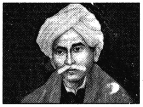
ఈయన ఆంధ్రదేశంలో విజయనగరం జిల్లావాడు. సమాజంలో ఉన్న ‘కన్యాశుల్కం’ అనే దురాచారాన్ని పోగొట్టడానికి “కన్యాశుల్కం” అనే నాటకాన్ని రచించాడు.
5) కనుపర్తి వరలక్ష్మమ్మ :

ఈమె భర్త ప్రోత్సాహంతో “స్త్రీ హితైషిణీ మండలి”ని స్థాపించి, స్త్రీ విద్యను ప్రోత్సహించింది. స్త్రీలకు ఓటుహక్కు కోసం ప్రయత్నించింది.
6) దుర్గాబాయి దేశ్ ముఖ్ :

ఈమె మద్రాసు, హైదరాబాదు నగరాలలో ఆంధ్ర మహిళాసభ ద్వారా స్త్రీలకు పాఠశాలలు, కళాశాలలు స్థాపించింది. స్త్రీలకు నర్సింగ్, కుట్టుపని వంటి వాటిలో శిక్షణ ఇప్పించింది.
(లేదా)
వివిధ రంగాలలో ప్రసిద్ధిగాంచిన స్త్రీల వివరాలను సేకరించి ప్రదర్శించండి.
జవాబు:
1) ఝాన్సీ లక్ష్మీబాయి : స్వాతంత్ర్య ఉద్యమంలో కత్తిపట్టి బ్రిటిష్ వారితో పోరాడి ప్రాణాలు కోల్పోయింది.
2) ఇందిరాగాంధీ : సుమారు 17 సంవత్సరాలు భారతదేశ ప్రధానమంత్రిగా పనిచేసింది.
3) సునీతా విలియమ్స్ : భారత సంతతికి చెందిన అమెరికా అంతరిక్ష పరిశోధకురాలు.
4) మార్గరెట్ థాచర్ : బ్రిటన్ ప్రధానమంత్రి.
5) శ్రీమతి భండారునాయకే : శ్రీలంక అధ్యక్షురాలు.
6) – సరోజినీ నాయుడు : స్వరాజ్య సమరంలో పాల్గొంది.
7) కల్పనా చావ్లా : అంతరిక్షంలో ఎగిరిన మహిళ
8) దుర్గాబాయి దేశ్ ముఖ్ : మహిళాభివృద్ధికి కృషి చేసింది.
9) సానియా మీర్జా గొప్ప టెన్నిస్ క్రీడాకారిణి.
10) సైనానెహ్వాల్ : బ్యాడ్మింటన్ క్రీడాకారిణి.
11) సావిత్రీబాయి ఫూలే : స్త్రీలకు విద్య నేర్పడం – సమాజ సేవ.
12) కరణం మల్లేశ్వరి . : సుప్రసిద్ధ వెయిట్ లిఫ్టర్ (ఒలింపిక్ పతక గ్రహీత)
III. భాషాంశాలు
పదజాలం
1. కింది పర్యాయపదాలకు సంబంధించిన పదాన్ని పాఠంలో గుర్తించి గడిలో రాయండి.
అ) …………… – ఆదేశము, ఆన, ఉత్తరువు, నిర్దేశము.
ఆ) …………… – అక్షి, చక్షువు, నేత్రము, నయనము.
ఇ) …………… – అగ్ని, వహ్ని, జ్వలనుడు.
ఈ) …………… – మగువ, కొమ్మ, ఇంతి, పడతి
జవాబు:
అ) ఆజ్ఞ
ఆ) కన్ను
ఇ) అనలము
ఈ) సతి
2. కింది ఆధారాలను బట్టి గళ్ళను పూరించండి.
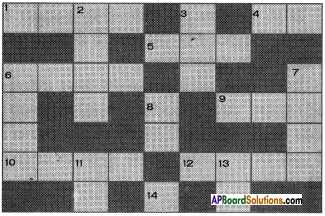
| అడ్డం : |
నిలువు : |
| 1. సీతకు అగ్నిగుండం కూడా ఇలా ఉంటుంది (4) |
2. సోన్ దేవుడు దీన్ని బంధించాడనే శివాజీ కోపించింది (4) |
| 4. ‘అంబుదం’ దీన్నే ఇలా కూడా అంటారు (2) |
6. రావణుని తాత (4) |
| 3. శివాజీ గౌరవించిన కాంత వంశం (3) |
7. యవన కాంత స్వస్థలం (4) |
| 5. సావిత్రి చరిత్ర విశేషణం (3) |
8. సోన్ దేవుని మదోన్మాదానికి కారణం (2) |
| 6. పాపం కాదు పుణ్యానికి నిలయం (4) |
11. శివాజీని సో దేవుడు పిలిచినట్లు మీరూ పిలవండి (2) |
| 9. కుడివైపు నుండి సీతకు మరో పేరు (3) |
13. శీర్షాసనం వేసిన త్వరితం, వేగం (2) |
| 10. కుడివైపు నుండి శివాజీ కోపించిన సేనాని (4) |
|
| 12. ఈ పాఠం కవి ఇంటి పేరు (4) |
|
| 14. పాఠంలో శివాజీ తొలిపలుకు (1) |
|

3. కింది ప్రకృతులకు సరైన వికృతులను జతపరచండి.
వికృతి
| ప్రకృతి |
వికృతి |
| అ) రాజ్జి |
1) ఆన |
| ఆ) ఆజ్ఞ |
2) రతనము |
| ఇ) ఛాయ |
3) బత్తి |
| ఈ) రత్నము |
4) రాణి |
| ఉ) భక్తి |
5) చాయ |
జవాబు:
| ప్రకృతి |
వికృతి |
| అ) రాజ్జి |
4) రాణి |
| ఆ) ఆజ్ఞ |
1) ఆన |
| ఇ) ఛాయ |
5) చాయ |
| ఈ) రత్నము |
2) రతనము |
| ఉ) భక్తి |
3) బత్తి |
4. ఈ కింది పదాలకు వ్యుత్పత్యర్థాలు రాయండి.
శివుడు : సాధువుల హృదయాన శయనించి ఉండువాడు, మంగళప్రదుడు (ఈశ్వరుడు)
పతివ్రత : పతిని సేవించుటయే వ్రతంగా కలిగినది (సాధ్వి)
పురంధి : గృహమును ధరించునది (గృహిణి)
అంగన : చక్కని అవయవముల అమరిక కలది (అందగత్తె)

5. ఈ కింది పదాలకు నానార్థాలు రాయండి.
వాసము : ఇల్లు, వస్త్రం
సూత్రము : నూలిపోగు, తీగె, త్రాడు
చరణము : పాదము, కిరణము, పద్యపాదము
హరి : యముడు, సింహము, ఇంద్రుడు
రత్నము : మణి, స్త్రీ, ముంత
6. కింది పదాల్లోని ప్రకృతి – వికృతి పదాలను వేరుచేసి రాయండి.

| ప్రకృతి |
వికృతి |
| గౌరవము |
గారవము |
| పుణ్యము |
పున్నెం |
| రాశి |
రాసి |
| అంబ |
అమ్మ |
| దోషము |
దోసము |
| బ్రహ్మ |
బమ్మ |
| జ్యోతి |
జోతి |
| గృహము |
గీము |
| భాగ్యము |
బాగ్గెము |
వ్యాకరణాంశాలు
1. కింది పదాలు పరిశీలించండి. వాటిలో సవర్ణదీర్ఘ గుణ, వృద్ధి సంధులున్నాయి. గుర్తించి, విడదీసి సూత్రాలు రాయండి.
అ) పుణ్యావాసము
ఆ) మదోన్మాదము
ఇ) స్నిగ్గాంబుద
ఈ) సరభసోత్సాహం
ఉ) గుణోద్ధత్యం
ఊ) రసైకస్థితి
అ) సవర్ణదీర్ఘ సంధి
సూత్రము ‘అ, ఇ, ఉ, ఋ లకు అవే (సవర్ణ) అచ్చులు పరములయినచో వానికి దీర్ఘములు వచ్చును.
అ) పుణ్యవాసము = పుణ్య + ఆవాసము – (అ + ఆ = ఆ)
ఇ) స్నిగ్లాంబుద = స్నిగ + అంబుద . (అ + అ = ఆ)
ఆ) గుణ సంధి –
సూత్రము ‘అకారమునకు ఇ, ఉ, ఋ లు పరమైన వానికి క్రమముగా ఏ, ఓ, అర్లు ఆదేశమగును.
ఆ) మదోన్మాదము – మద + ఉన్మాదము – (అ + ఉ = ఓ)
ఈ) సరభసోత్సాహం = సరభస + ఉత్సాహం – (అ + ఉ = ఓ)
ఇ) వృద్ధి సంధి
సూత్రము అకారమునకు ఏ, ఐ లు పరమైన ‘ఐ’ కారం, ఓ, ఔ లు పరమైన ‘జై’ కారం ఆదేశమగును.
ఉ) గుణోద్ధత్యం – గుణ + ఔద్దత్యం – (అ + ఔ – ఔ)
ఊ) రసైకస్థితి : రస + ఏకసితి – (అ + ఏ = ఐ)

2. కింది పదాల్లో ఉత్వ, త్రిక, రుగాగమ, లులనల సంధులున్నాయి. పదాలు విడదీసి, సంధి జరిగిన తీరును చర్చించండి.
అ బంధమూడ్చి
ఆ) అవ్వారల
ఇ) భక్తురాలు
ఈ) బాలెంతరాలు
ఉ) గుణవంతురాలు
ఊ) దేశాల
ఋ) పుస్తకాలు
ఋా) సమయాన
ఉత్వ సంధి
సూత్రము :
ఉత్తునకచ్చు పరమగునపుడు సంధియగు.
అ) బంధమూడ్చి = బంధము + ఊడ్చి – (ఉ + ఊ – ఊ)
త్రిక సంధి
సూత్రము :
- ఆ, ఈ, ఏ లు త్రికమనబడును – (ఆ + వారల)
- త్రికము మీది అసంయుక్త హల్లునకు ద్విత్వంబు బహుళంబుగానగు – (ఆ + వ్వారల)
- ద్విరుక్తంబగు హల్లు పరమగునపుడు ఆచ్చికమగు దీర్ఘమునకు హ్రస్వంబగు – (అవ్వారల)
ఆ) అవ్వారల = ఆ + వారల – త్రిక సంధి
రుగాగమ సంధి
సూత్రము :కర్మధారయము నందు తత్సమంబులకు ‘ఆలు’ ‘శబ్దం పరమగునపుడు అత్వంబునకు ఉత్వమును, – రుగాగమంబును అగును.
ఇ) భక్తురాలు : భక్త + ఆలు – భక్తురు(క్) + ఆలు
ఉ) గుణవంతురాలు – గుణవంత + ఆలు – గుణవంతురు(క్) + ఆలు
సూత్రము :పేదాది శబ్దములకు ‘ఆలు’ శబ్దం పరమగునపుడు రుగాగమంబగు.
ఈ) బాలెంతరాలు : బాలెంత + ఆలు – రుగాగమ సంధి
లు ల న ల సంధి
సూత్రము : లు ల న లు పరంబగునపుడు ఒకానొకచోట ముగాగమంబునకు లోపంబును, దాని పూర్వస్వరమునకు దీర్ఘమును విభాషనగు.
ఊ) దేశాల = దేశము + ల – (‘ము’ లోపం – దాని పూర్వపు ‘శ’ కు దీరం వచ్చింది.)
ఋ) పుస్తకాలు : పుస్తకము + లు – (‘ము’ లోపం – దాని పూర్వపు ‘క’ కు దీర్ఘం వచ్చింది.)
ఋా) సమయాన = సమయము + న – (‘ము’ లోపం – దాని పూర్వపు ‘య’ కు దీర్ఘం వచ్చింది.)
3. కింది పద్యపాదాల్లోని అలంకారాన్ని గుర్తించండి. లక్షణాలను సరిచూసుకోండి. అ) అనుచున్ జేవుఱుమీజు కన్నుఁగవతో నాస్పందితోష్ఠంబుతో ఘన హుంకారముతో నటద్ర్భుకుటితో గర్జిల్లు నా భోలే శునిఁ జూడన్ ………
జవాబు:
ఈ పద్యపాదాలలో స్వభావోక్తి అలంకారం ఉంది. భానసలేశుని కోపాన్ని ఉన్నదున్నట్లుగా వర్ణించారు కనుక ఇది స్వభావోక్తి అలంకారం.
4. కింది పద్యపాదాలకు గురులఘువులను గుర్తించి, గణవిభజనచేసి, అవి ఏ పద్యాలకు సంబంధించినవో నిర్ణయించండి. లక్షణాలను చర్చించండి.
అ) ఆ – యేమీ యొక రాణివాసమును బుణ్యవాసమున్ దెచ్చినా
జవాబు:

లక్షణాలు :
- ఈ పద్యపాదం ‘శార్దూలం’ వృత్తానికి చెందింది.
- యతి 13వ అక్షరం – ‘ఆ’ కు 13వ అక్షరమైన ‘జ్యా’ లో ‘య’ తో యతి.
- ప్రాస నియమం కలదు.
- 4 పాదాలుంటాయి.
ఆ) అనలజ్యోతుల నీ పతివ్రతలఁ బాపాచారులై డాయు భూ
జవాబు:

లక్షణాలు :
- ఈ పద్యపాదం ‘మత్తేభం’ వృత్తానికి చెందింది.
- యతి 14వ అక్షరం – ‘అ’ కు 14వ అక్షరమైన ‘పాప + ఆచారులు’ లోని పరపదమైన ‘ఆచారులు’ లోని ‘ఆ’ తో యతి చెల్లినది.
- ప్రాస నియమం కలదు.
- 4 పాదాలుంటాయి.
5. కింది పదాలను విడదీయండి.
అ) వాజ్మయం = వాక్ + మయం – ‘క్’ స్థానంలో ‘ఙ’ వచ్చింది.
ఆ) రాణ్మహేంద్రవరం = రాట్ + మహేంద్రవరం – ‘ట్’ కు బదులుగా ‘ణ’ వచ్చింది.
ఇ) జగన్నాథుడు = జగత్ + నాథుడు – ‘త్’ కు బదులుగా ‘న’ వచ్చింది.
అంటే మొదటి పదంలోని క కారం పోయి క వర్గ అనునాసికమైన ఙ (క, ఖ, గ, ఘ, ఙ), ట కారం పోయి ట వర్గ అనునాసికమైన ‘ణ’ (ట, ఠ, డ, ఢ, ణ), ‘త’ కారం పోయి త వర్గ అనునాసికమైన ‘న’ (త, థ, ద, ధ, న) వచ్చాయి కదా! అలాగే మొదటి పదం చివర ‘చ’ కారం ఉంటే చ వర్గ అనునాసికమైన ‘ఞ’ (చ, ఛ, జ, ఝ, ఞ), ‘ప’ కారం ఉంటే పవర్గ అనునాసికమైన ‘మ’ (ప, ఫ, బ, భ, మ) వస్తాయి.
దీనిని సూత్రీకరిస్తే : క, చ, ట, త, ప వరాక్షరాలకు న, మ లు పరమైతే వాని వాని అనునాసికాక్షరాలు వికల్పంగా వస్తాయి. దీనినే ‘అనునాసిక సంధి’ అంటారు.
కింది పదాలను విడదీసి, అనునాసిక సంధి సూత్రంతో అన్వయించి చూడండి.
అ) తన్మయము
ఆ) రాణ్మణి
ఇ) మరున్నందనుడు
జవాబు:
అ) తన్మయము = తత్ + మయము . ‘త్’ కు బదులుగా ‘మ’ వచ్చింది.
ఆ) రాణ్మణి = రాట్ + మణి – ‘ట్’ కు బదులుగా ‘ణ’ వచ్చింది.
ఇ) మరున్నందనుడు = మరుత్ + నందనుడు – ‘త్’ కు బదులుగా ‘న’ వచ్చింది.
అంటే క, చ, ట, త, ప వర్గాక్షరాలకు న, మ లు పరమైతే వాని అనునాసికాక్షరాలు వికల్పంగా వచ్చును.
6. ఉపజాతి పద్యాల్లో తేటగీతి, ఆటవెలది పద్యాల లక్షణాలను తెలుసుకున్నారు కదా ! ఇప్పుడు సీసపద్య లక్షణాలను పరిశీలిద్దాం.
తేటగీతి:
- ఇది ఉపజాతి పద్యం .
- దీనిలో 4 పాదాలు ఉంటాయి.
- ప్రతి పాదంలోను వరుసగా ఒక సూర్యగణం, 2 ఇంద్రగణాలు, 2 సూర్యగణాలు ఉంటాయి.
- 4వ గణం మొదటి అక్షరం యతి. ప్రాసయతి అయినా వేయవచ్చును.
- ప్రాస నియమం లేదు.
ఉదా :

ఆటవెలది :
- ఇది ఉపజాతి పద్యం .
- దీనిలో 4 పాదాలు ఉంటాయి.
- 1వ పాదంలో వరుసగా 3 సూర్యగణాలు, 2 ఇంద్రగణాలు ఉంటాయి.
- 3వ పాదంలో కూడా ఇలానే ఉంటాయి.
- 2వ పాదంలోను, 4వ పాదంలోను వరుసగా 5 సూర్యగణాలు ఉంటాయి.
- ప్రతి పాదంలోను యతి 4వ గణం మొదటి అక్షరం.
- ప్రాసయతిని అయినా వేయవచ్చును.
- ప్రాస నియమం లేదు.
ఉదా :
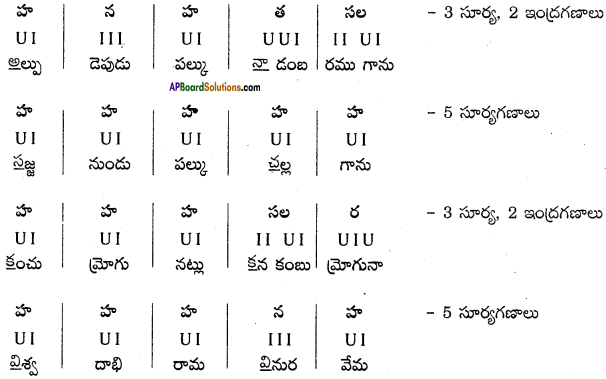
సీసపద్యం :
సీసపద్యంలో ప్రతిపాదం రెండు భాగాలుగా ఉంటుంది. ప్రతి భాగంలో నాల్గేసి గణాల చొప్పున ఒక్కొక్క పాదంలో ఎనిమిది గణాలుంటాయి. ఈ 8 గణాల్లో మొదటి ఆరు ఇంద్రగణాలు. చివరి రెండు సూర్యగణాలు. (పాదం మొదటి భాగంలో 4 ఇంద్రగణాలు, 2వ భాగంలో వరుసగా రెండు ఇంద్రగణాలు, రెండు సూర్యగణాలుంటాయి.)
ఉదా :
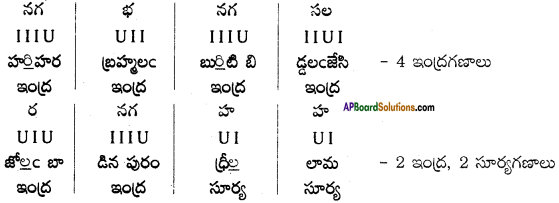
లక్షణాలు :
- 4 పాదాలుంటాయి.
- ప్రతి పాదం 2 భాగాలుగా ఉంటుంది.
- మొదటి భాగంలో 4 గణాలుంటాయి. 2వ భాగంలో 4 గణాలుంటాయి.
- రెండు భాగాలలోను 3వ గణం మొదటి అక్షరం యతి. లేక ప్రాసయతి చెల్లుతుంది.
- మొదటి భాగంలో 4 ఇంద్రగణాలుంటాయి.
- 2వ భాగంలో 2 ఇంద్ర, 2 సూర్య గణాలుంటాయి.
- ప్రాస నియమం లేదు.
- 4 పాదాల (8 పాదభాగాలు) తర్వాత తేటగీతి గాని, ఆటవెలది గాని తప్పనిసరిగా ఉండాలి.

ఈ కింది పద్య పాదాన్ని గణ విభజన చేసి లక్షణ సమన్వయం చేయండి.
ధగధగ ద్దహనమధ్యము పూలరాసిగా
విహరించియున్న సాధ్వీమతల్లి.

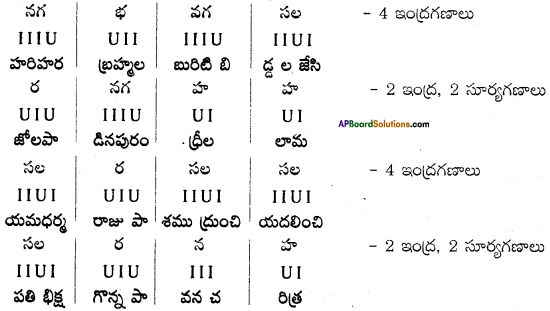
మీ పాఠంలోని 5వ పద్యం సీసం. ఆ పద్యం లక్షణాలు సరిచూడండి.

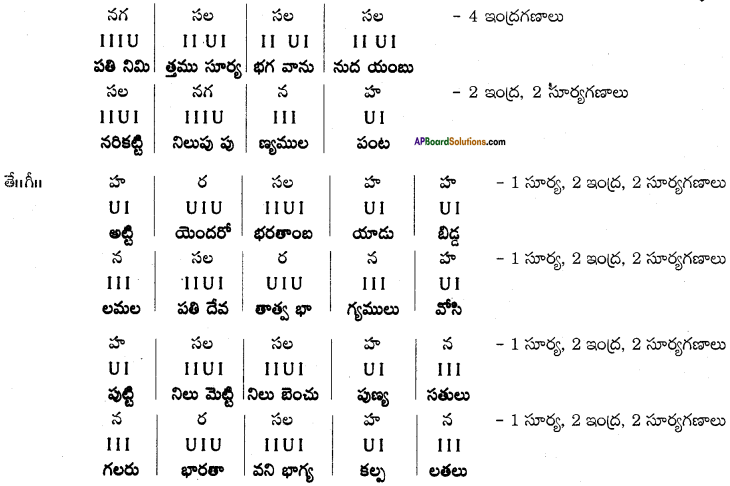
అదనపు సమాచారము
సంస్కృత సంధులు
1. సవర్ణదీర్ఘ సంధి:
1) భారతావని భారత + అవని – సవర్ణదీర్ఘ సంధి
2) దుశ్చరితాలోచన దుశ్చరిత + ఆలోచన – సవర్ణదీర్ఘ సంధి
3) పాపాచారులు = పాప + ఆచారులు – సవర్ణదీర్ఘ సంధి
4) భరతాంబ = భరత + అంబ – సవర్ణదీర్ఘ సంధి
5) మదీయాదర్శము = మదీయ + ఆదర్శము – సవర్ణదీర్ఘ సంధి
6) సూక్తి = సు + ఉక్తి – సవర్ణదీర్ఘ సంధి
2. గుణ సంధి :
7) బోన్ సలేశుడు = బోన్ సల + ఈశుడు – గుణసంధి
8) అజోల్లంఘన = ఆజ్ఞ + ఉల్లంఘన – గుణసంధి
9) ఉల్లంఘనోద్వృత్తి = ఉల్లంఘన + ఉద్వృతి – గుణసంధి
3. జశ్వ సంధి:
10) నటద్ర్భుకుటి = నటత్ + భ్రుకుటి – జత్త్వసంధి
11) భవదాజ్ఞ = భవత్ + ఆజ్ఞ – జత్త్వసంధి

4. అనునాసిక సంధి :
12) అసన్మార్గంబు = అసత్ + మార్గంబు – అనునాసిక సంధి
5. శ్చుత్వ సంధి:
13) దుశ్చరితము = దుస్ +చరితము – శ్చుత్వసంధి
14) దుశ్చరిత్రము = దుస్ + చారిత్రము – శ్చుత్వసంధి
15) అస్మచ్ఛబ్దము = అస్మత్ + శబ్దము – శ్చుత్వసంధి
తెలుగు సంధులు
1. అత్వ సంధి:
1) పుట్టినిల్లు = పుట్టిన + ఇల్లు – అత్వసంధి
2) మెట్టినిల్లు = మెట్టిన + ఇల్లు – అత్వసంధి
2. ఉత్వ సంధి:
3) తోడంపు = తోడు + అంపు – ఉత్వసంధి
4) పుయిలోడు = పుయిలు + ఓడు – ఉత్వసంధి
3. గసడదవాదేశ సంధి :
5) భాగ్యములు వోసి = భాగ్యములు + పోసి – గసడదవాదేశ సంధి
6) భిక్షగొన్న = భిక్ష + కొన్న – గసడదవాదేశ సంధి
4. నుగాగమ సంధి :
7) భగవానునుదయము= భగవాను + ఉదయము – నుగాగమ సంధి
8) కన్నుఁగవ = కన్ను + కవ (కన్ను + న్ + కవ) – నుగాగమ సంధి
9) ముసుంగుఁదెర = ముసుంగు + తెర (ముసుంగు + న్ + తెర) – నుగాగమ సంధి

5. యడాగమ సంధి:
10) మాయాజ్ఞ = మా + ఆజ్ఞ – యడాగమ సంధి
11) ఈ యాజ్ఞ = ఈ + ఆజ్ఞ – యడాగమ సంధి
సమాసాలు
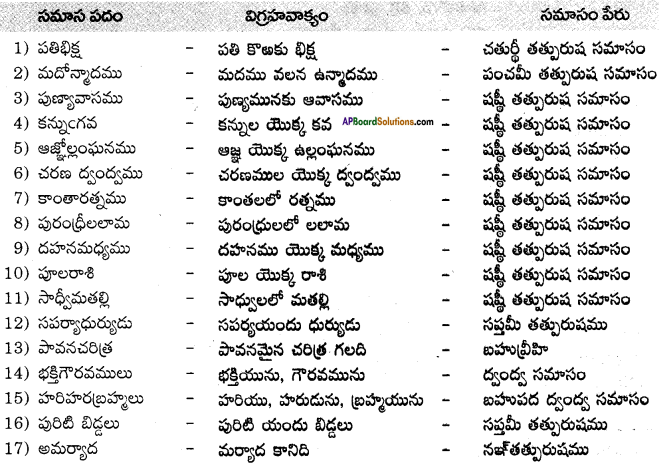
ప్రకృతి – వికృతి
జ్యోతి – జోతి
మర్యాద – మరియాద
రాట్టు – ఱేడు
ఈర్ష్య – ఈసు
రాశి – రాసి
బంధము – బందము
సూక్ష్మత – సుంత
బిక్ష – బిచ్చము, బికిరము
భక్తి – బత్తి
మణి – మిన్
భాగ్యము – బాగైం
రూపము – రూపు
ఛాయ – చాయ
భూమి – బూమి
పుత్రుడు – బొట్టె
రాజ్ఞి – రాణి
బ్రహ్మ – బమ్మ, బొమ్మ
దోషము – దోసము, దొసగు
పుణ్యము – పున్నెము
గృహము – గీము
భయము – పుయిలు
సూక్తి – సుద్ది
ద్వంద్వము – దొందము
ముఖము – మొగము
గౌరవము – గారవము
స్త్రీ – ఇంతి
రత్నము – రతనము
ఆజ్ఞ – ఆన
ఓష్ఠము – ఔడు
నానార్థాలు
1. బలము : సత్తువ, సేన, వాసన
2. తోడు : సహాయము, నీరువంటి వాటిని పైకి లాగడం, తోడబుట్టినవాడు
3. పాశము : తాడు, గుంపు, బాణము, ఆయుధము
4. పుణ్యము : ధర్మము, పవిత్రత, నీరు
5. సూత్రము : నూలిపోగు, తీగె, త్రాడు
6. బంధము : కట్ట, దారము, సంకెల, దేహము
7. రూపము : ఆకృతి, సౌందర్యము
8. చరణము : పాదము, కిరణము, పద్యపాదము
9. సంపద : ఐశ్వర్యము, సౌఖ్యము, లాభము, ధనము
10. ఛాయ : నీడ, పార్వతి, పోలిక
11. భిక్షము : బిచ్చము, కూలి, కొలువు
12. గౌరవము : బరువు, మన్నన, గొప్పతనము
18. సంతానము : బిడ్డ, కులము, వరుస
14. హరి : విష్ణువు, ఇంద్రుడు, సూర్యుడు, గుఱ్ఱము, కోతి
15. దోసము : పాపము, తప్పు, లోపము
16. మర్యా ద : కట్టుబాటు, పొలిమేర, నడత, నిష్ఠ
పర్యాయపదాలు
1. తల్లి : జనయిత్రి, మాత, అమ్మ, జనని
2. ఆజ్ఞ : ఆదేశము, ఆన, ఉత్తరువు, ఆనతి, ఆజ్ఞప్తి
3. కన్ను : చక్షువు, నేత్రము, నయనము, అక్షి
4. పతివ్రత : సాధ్వి, పురంధి, పతిదేవత, సతి
5. దోషము : దోసము, దొసగు, తప్పు, అపరాధము
6. దేవతలు : అమరులు, వేల్పులు, విబుధులు, నిర్జరులు
7. అంబుధి : ఉదధి, పారావారము, కడలి, సముద్రము
8. హరి : విష్ణువు, చక్రి, నారాయణుడు, వైకుంఠుడు
9. బ్రహ్మ : పద్మభవుడు, చతుర్ముఖుడు, నలువ
10. కాంత : స్త్రీ, వనిత, చెలువ, మహిళ, ఇంతి, ఆడుది, యువతి
11. బిడ్డ : కొడుకు, శిశువు, బాలుడు
12. అంబుదము : మేఘము, మొగులు, అంభోదము, జలదము, ఘనము
13. అనలము : అగ్ని, దహనము, శుచి, వహ్ని
14. ముఖము : మొగము, ఆననము, వదనము, మోము
15. భూమి : ధరణి, అవని, ధర, పృథివి
వ్యుత్పత్త్యర్థాలు
1. అంబుదము : నీటినిచ్చునది (మేఘము)
2. పురంధి : గృహమును ధరించునది (ఇల్లాలు)
3. పతివ్రత : పతిని సేవించుటయే వ్రతముగా గలది (సాధ్వి)
4. జనని : సంతానమును ఉత్పత్తి చేయునది (తల్లి)
5. దహనము : కాల్చుటకు సాధనమైనది (అగ్ని)
కవి పరిచయం
పేరు : డా|| గడియారం వేంకటశేష శాస్త్రి
తల్లితండ్రి : తల్లి నరసమాంబ, తండ్రి రామయ్య, కడప జిల్లా, జమ్మలమడుగు తాలుకా
నెమళ్ళ దిన్నె గ్రామంలో 1894లో జన్మించారు. కడప మండలం ప్రొద్దుటూరు మునిసిపల్ హైస్కూల్లో తెలుగు పండితులుగా
పనిచేశారు. వీరు శతావధాని.
రచనలు : రాజశేఖర శతావధాని గారితో కలిసి కొన్ని కావ్యాలు, నాటకాలు రచించారు. ‘శ్రీ శివభారతం’ వీరికి చాలా పేరు తెచ్చిన కావ్యం. పారతంత్ర్యాన్ని నిరసించి స్వాతంత్ర్యకాంక్షను అణువణువునా రగుల్కొల్పిన మహాకావ్యం ఇది. మురారి, పుష్పబాణ విలాసము, వాస్తు జంత్రి (అముద్రిత వచన రచన), మల్లికామారుతము, శ్రీనాథ కవితా సామ్రాజ్యము (విమర్శ), రఘునాథీయము అనే కావ్యాలు రచించారు.
బిరుదులు :
కవితావతంస, కవిసింహ, అవధాన పంచానన అనేవి వారి బిరుదులు.
పద్యాలు – ప్రతిపదార్థాలు – భావాలు
అవగాహన – ప్రతిస్పందన
పద్యం – 1 : కంఠస్థ పద్యం
శా॥ “ఆ యేమీ ? యొక రాణివాసమును బుణ్యవాసమున్ దెచ్చినా
వా? యే హైందవుఁడైన నీ గతి నమర్యాదన్ బ్రవర్తించునే?
మా యాజ్ఞన్ గమనింపవో ? జయ మదోన్మాదంబునన్ రేఁగి, నీ
యాయుస్సూత్రము లీవ క్రుంచుకొనేదో ? యౌధ్ధత్య మోర్వన్ జుమీ”
ప్రతిపదార్థం :
ఆ – యేమీ? = ఆ, ఏమిటీ? (ఆశ్చర్యం, కోపంతో)
పుణ్యవాసముల్ (పుణ్య + ఆవాసమున్) = పుణ్యానికి నిలయమైన
ఒక = ఒక
రాణివాసమును = అంతఃపురమును (మహారాణిని)
తెచ్చినావా? = బందీగా తీసుకొని వచ్చావా?
ఏ, హైందవుడు + ఐనన్ = ఏ హిందువైనా (భారతీయుడెవరైనా)
ఈ గతిన్ = ఈ విధంగా
అమర్యాదన్ ప్రవర్తించునే = గౌరవం లేకుండా
ప్రవర్తించును + ఏ = ప్రవర్తిస్తాడా? (ప్రవర్తించడు)
మా + ఆజ్ఞన్ = మా ఆజ్ఞను (రాజాజ్ఞను)
గమనింపవు + ఓ = పట్టించుకోవా?
జయ = జయం వలన
మద = గర్వంతో
ఉన్నాదంబునన్ = మితిమీరిన పిచ్చితనముతో
రేఁగి = విజృంభించి
నీ = నీ యొక్క
ఆయుస్సూత్రములు = ఆయుర్దాయపు నూలిపోగులు (ప్రాణాలు)
ఈవ త్రుంచుకొనెదు + ఓ = త్రెంచుకొంటావా?
ఔద్ధత్యము = గర్వంతో చేసే పనులను
ఓర్వన్ = సహించను
చుమీ = సుమా!
భావం :
“ఆ-ఏమిటీ? పుణ్యానికి నిలయమైన ఒక రాణి వాసాన్ని బంధించి తీసుకొనివచ్చావా? ఏ భారతీయుడైనా ఈ విధంగా గౌరవం లేకుండా ప్రవర్తిస్తాడా? రాజాజ్ఞను కూడా పట్టించుకోవా? జయం వలన గర్వంతో, మితిమీరిన పిచ్చితనంతో విజృంభిస్తావా? నీ ప్రాణాలు నీవే తెంచుకొంటావా? గర్వాన్ని సహించను సుమా !” అని శివాజీ, సో దేవునితో ఆగ్రహంగా అన్నాడు.
పద్యం – 2
మ|| | అనుచున్ జేవుజు మీ జు కన్నుఁగవతో నాస్పందితోష్ణంబుతో
ఘన హుంకారముతో నటద్భుకుటితో గర్జిల్లు నా భోసలే
శునిఁ జూదన్ బుయిలోడెఁ గొల్వు శివుఁడీసున్ గుత్తుకన్ మ్రింగి, బో
రన నవ్వారల బంధ మూడ్చి గొని తేరన్ బంచె సోన్ దేవునిన్
ప్రతిపదార్థం :
అనుచున్ = శివాజీ అలా హెచ్చరిస్తూ (ఆ విధంగా చెపుతూ)
జేవుఱుమీటు = జేగురు రంగును (ఎరుపు రంగును) అతిశయించే (జేగురు రంగు కంటే ఎఱ్ఱగా నున్న)
కన్నుఁగవతోన్ = కనుల జంటతో
ఆస్పందదోష్ఠంబుతోన్; ఆస్పందత్ = కొలదిగా కదులుతున్న
ఓష్ఠంబుతోన్ = పెదవితో
ఘనహుంకారముతోన్ = గొప్ప హుంకార ధ్వనితో
నటద్ర్భుకుటితోన్; నటత్ = నాట్యము చేయుచున్న (బాగా కదలి ఆడుచున్న)
భ్రుకుటీతోన్ = కనుబొమల ముడితో
గర్జీల్లు = గర్జిస్తున్న
ఆ ఫోన్సలేశునిన్ (ఆ ఫోన్సల + ఈశునిన్) = ఆభోంసల వంశ ప్రభువైన శివాజీని
చూడన్ = చూడ్డానికి
కొల్వు = రాజసభ
పుయిలోడెన్ = జంకింది (భయపడింది.) (నిశ్చేష్టులయ్యారు)
శివుడు = శివాజీ
ఈసున్ = (తన) కోపాన్ని
కుత్తుకన్ = గొంతుకలో
మ్రింగి = అణచుకొని
బోరనన్ = శీఘ్రముగా (ఇది ‘బోరునన్’) అని ఉండాలి.)
అవ్వారల = వారి యొక్క (కళ్యాణి సర్దారు యొక్క ఆతని అంతఃపురకాంత యొక్క
బంధమూడ్చి (బంధము + ఊడ్చి) – సంకెలలు తొలగించి,
కొనితేరన్ = తీసికొనిరావడానికి (సభలోకి తీసుకురావడానికి)
సోన్ దేవునిన్ = (తన సైన్యాధిపతియైన, వారిని బంధించి తెచ్చిన) సోన్ దేవుడిని
పంచెన్ = ఆజ్ఞాపించెను.
భావం:
అంటూ ఎర్రబడిన కన్నులతో, అదిరిపడే పై పెదవితో, గొప్ప హుంకారముతో, కదలియాడే కనుబొమ్మల ముడితో, గర్జిస్తున్న ఆ ఫోన్సలేశుడైన శివాజీని చూడ్డానికి సభలోనివారు భయపడ్డారు. తరువాత శివాజీ తన కోపాన్ని గొంతుకలో అణచుకొని, వెంటనే వారి సంకెళ్లను తొలగించి, తీసుకొని రమ్మని, సో దేవుడిని ఆజ్ఞాపించాడు.
పద్యం – 3
మ|| | త్వరితుండై యతఁ డట్టులే నలిపి “దేవా! నన్ను మన్నింపు; మీ
సరదారున్ గొని తెచ్చుచో సరభసోత్సాహంబు కగ్గప్పె; దు
శృరితాలోచన లేదు, లేదు భవదాజా లంఘనోద్వృత్తి; మీ
చరణద్వంద్వమునాన” యంచు వినిపించన్, సుంత శాంతించుచున్
ప్రతిపదార్థం :
త్వరితుండు + ఐ = తొందర కలవాడై
అతడు = ఆసోన్ దేవుడు
అట్టులే = ఆ విధంగానే (శివాజీ చెప్పినట్లుగానే)
సలిపి = చెసి
దేవా = దేవా (శివాజీని దైవమా ! అని సంబోధించి)
నన్ను = నన్ను (సోన్ దేవుని)
మన్నింపుము = అపరాధమును క్షమింపుము
ఈ సరదారున్ = (ఓడిపోయిన) ఈ వీరుడిని
కొని తెచ్చుచో = తీసుకొని వచ్చేటపుడు
సరభస + ఉత్సాహంబు = ఉవ్విళ్ళూరు ఉత్సాహము
కన్దప్పె = కళ్లకు కమ్మేసింది
దుస్+చరిత + ఆలోచన = చెడు చేయాలనే తలంపు
లేదు = లేదు
మీ = తమ యొక్క
చరణద్వంద్వంబులు = పాదాలు
ఆన = సాక్షి (ఒట్టు)గా
భవత్ = తమ యొక్క
ఆజ్ఞ = ఆజ్ఞను
ఉల్లంఘన = అతిక్రమించాలనే
ఉద్వృత్తి = గర్వము
లేదు = లేదు
అంచు = అనుచు
వినిపించన్ = నివేదించగా
సుంత = కొద్దిగా
శాంతించుచున్ – శాంతిని పొందినవాడై (కోపం తగ్గినవాడై)
భావం :
శివాజీ ఆజ్ఞాపించిన పనిని సోదేవుడు తొందరగా చేశాడు. “దేవా! నన్ను మన్నించండి. ఓడిపోయిన ఈ వీరుడిని బంధించి తెచ్చేటప్పుడు ఉవ్విళ్ళూరు ఉత్సాహం కళ్లకు కమ్మేసింది. మీ పాదాల సాక్షిగా నాకు చెడు చేయాలనే ఆలోచన లేదు. తమ ఆజ్ఞను అతిక్రమించాలనే గర్వంలేదు.” అని నివేదించగా శివాజీ కొద్దిగా శాంతించాడు.
పద్యం – 4 : కంఠస్థ పద్యం
*మ|| శివరాజంతట మేల్ముసుంగుఁ దెరలో – స్నిగ్జాంబుదద్ఛాయలో
నవసౌదామినిఁ బోలు నా యవనకాంతారత్నమున్ భక్తి గా
రవముల్ వాజఁగఁ జూచి వల్కె “వనితారత్నంబు లీ భవ్యహైం
దవభూజంగమ పుణ్యదేవతలు; మాతా! తప్పు సైరింపుమీ !”
ప్రతిపదార్థం :
శివరాజు = శివాజీ మహారాజు
అంతటన = అప్పుడు
మేల్ముసుంగుఁదెరలోన్; మేల్ముసుంగు = సువాసినీ స్త్రీలు వేసుకొనే మేలు ముసుగు యొక్క (బురఖా)
తెరలోన్ = తెరలోపల
స్నిగ్దాంబుదచ్ఛాయలోస్, (స్నిగ్ధ+ అంబుద + ఛాయలోన్) స్నిగ్ధ = దట్టమైన
అంబుద = మేఘము యొక్క
ఛాయలోన్ = నీడలో (మాటున నున్న)
నవసౌదామినిన్ = కొత్త మెరుపు తీగను
పోలు = పోలినట్లు ఉన్న
ఆ, యవన కాంతారత్నమున్ = ఆ రత్నము వంటి యవనకాంతను (మహమ్మదీయ స్త్రీని)
భక్తి గౌరవముల్ = భక్తియునూ, గౌరవమునూ
పాఱగన్ + చూచి = స్ఫురించేటట్లు చూసి
పల్కెన్ = ఈ విధంగా అన్నాడు
వనితారత్నంబులు = రత్నముల వంటి స్త్రీలు (శ్రేష్ఠులైన స్త్రీలు)
ఈ = ఈ
భవ్య హైందవ భూ జంగమ పుణ్యదేవతలు; భవ్య = శుభప్రదమైన
హైందవ భూ = భారత భూమిపై
జంగమ = సంచరించే (తిరుగాడే)
పుణ్యదేవతలు = పుణ్యప్రదమైన దేవతల వంటివారు
మాతా! = అమ్మా
తప్పున్ = మా వారు చేసిన తప్పును
సైరింపుమీ = మన్నింపుము (క్షమింపుము)
భావం :
శివాజీ మహారాజు అప్పుడు మేలు ముసుగు తెరలో దట్టమైన నీలి మేఘం వెనుక ఉన్న మెరుపు తీగవంటి యవన కాంతను భక్తి గౌరవాలతో చూస్తూ ఇలా అన్నాడు. “స్త్రీలు శుభప్రదమైన ఈ హైందవ భూమిపై సంచరించే పుణ్యదేవతలు. అమ్మా ! మా తప్పును మన్నింపుము.”
చారిత్రక విశేషం :
అబ్బాజీసో దేవుడు అనే శివాజీ యొక్క సైన్యాధిపతి ‘కళ్యాణి’ కోటను పట్టుకొన్నాడు. అక్కడ అతడు ఒక అందమైన అమ్మాయిని బందీగా పట్టుకొన్నాడు. ఆ అమ్మాయి కళ్యాణి కోటకు గవర్నరు (సర్దారు) అయిన మౌలానా అహమ్మదుకు కోడలు. ఆ అమ్మాయిని సో దేవుడు శివాజీకి బహుమతిగా ఇచ్చాడు. అప్పుడు శివాజీ ఆ అమ్మాయితో “అమ్మా! నా తల్లి నీ అంత అందగత్తె అయి ఉన్నట్లయితే, నేను కూడా నీ అంత అందంగా కనబడేవాడిని” అని అన్నాడు. శివాజీ ఆ యవన కాంతను తన కూతురుగా ఆదరించాడు. ఆమెకు వస్త్రాలు ఇచ్చి, ఆమెను ఆమె ఇంటికి – బీజాపూరుకు పంపాడు. (ఇది చరిత్రలలో చెప్పబడింది)
పద్యం – 5
సీ॥ హరి హర బ్రహ్మలం బురిటిబిడ్డలం జేసి
జోలంబాడిన పురంద్రీలలామ,
యమధర్మరాజు పాశముం ద్రుంచి యదలించి
పతిభిక్ష గొన్న పావనచరిత్ర,
ధగధగ దహనమధ్యము పూలరాసిగా
విహరించియున్న సాధ్వీమతల్లి,
పతి నిమిత్తము సూర్యభగవానును దయంబు
నరికట్టి నిలుపు పుణ్యములవంట,
తే|| అట్టి యెందతో భరతాంబ యాఁదుబిద్ద
లమల పతిదేవతాత్వ భాగ్యములు వోసి
పుట్టినిలు మెట్టినిలుఁ బెంచు పుణ్యసతులు
గలరు, భారతావని భాగ్యకల్పలతలు
ప్రతిపదార్థం :
హరి హర బ్రహ్మలన్ = విష్ణువును, శివుని, బ్రహ్మను
పురిటి బిడ్డలన్ + చేసి = పసిపిల్లలుగా చేసి
జోలన్ = జోలపాటను
పాడిన = పాడినటువంటి
పురంధీలలామ = శ్రేష్ఠురాలైన గృహిణి (అనసూయ)
యమధర్మరాజు = మృత్యుదేవత యొక్క
పాశమున్ = త్రాడును
త్రుంచి = తెంచి
అదలించి = గద్దించి
పతిభిక్షన్ = భర్తను భిక్షగా
కొన్న = సంపాదించిన
పావన చరిత్ర = పవిత్రమైన చరిత్ర గలది; (సావిత్రి)
ధగధగత్ = ధగధగ మండుచున్న
దహన మధ్యము = చితి మధ్యభాగము
పూలరాసిగా = పూలకుప్ప వలె
విహరించియున్న = సంచరించి ఉన్నటువంటి
సాధ్వీమ తల్లి = శ్రేష్ఠురాలైన స్త్రీ (సీత)
పతి నిమిత్తము = పతి కొరకు
సూర్యభగవానుని = సూర్యదేవుని యొక్క
ఉదయంబును = ఉదయమును
అరికట్టి = నిరోధించి
నిలుపు = నిలిపిన
రతాంబ
పుణ్యముల పంట = తల్లిదండ్రుల పుణ్యఫలము (సుమతి)
అట్టి = అటువంటి
ఎందఱో = ఎంతోమంది
భరతాంబ = భరతమాత యొక్క
ఆఁడుబిడ్డలు = స్త్రీ సంతానం
అమల = స్వచ్చమైన
తిదేవతాత్వ = పతివ్రతా ధర్మమనెడు
భాగ్యములు + పోసి = సంపదలను ఇచ్చి
అట్టిన + ఇలున్ = పుట్టినింటిని
పెట్టిన + ఇలున్ = అత్తవారింటిని
పెంచు = అభివృద్ధి చేయు
భరత + అవని = భారతదేశము యొక్క
భాగ్య కల్పలతలు = సంపద అనెడు దేవతావృక్షాల వంటి
అణ్యసతులు = పుణ్యాత్ములైన స్త్రీలు
కలరు = ఉన్నారు
భావం :
బ్రహ్మ, విష్ణు, మహేశ్వరులను పసిపిల్లలుగా చేసి ద్రపుచ్చినది అనసూయ అను పేరు గల ఒక గృహిణి. దుమధర్మరాజు పాశమును కూడా ట్రెంచి, గద్దించి, పతి పాణాలు సాధించిన పవిత్రమైన చరిత్ర కలది సావిత్రి. నిప్పుల రాశి మధ్యను పూలరాశిగా సంచరించిన శ్రేష్ఠురాలైన స్త్రీ సీత. -తిప్రాణాలు కాపాడడానికి సూర్యోదయాన్ని నిలిపిన అణ్యాత్మురాలు సుమతి. అటువంటి భరతమాత సంతానమైన స్త్రీలు స్వచ్ఛమైన పతివ్రతలు. వారి పాతివ్రత్య మహిమతో అట్టింటిని, అత్తవారింటిని అభివృద్ధి చేస్తున్నారు. వారు ఈ కారతదేశపు సంపదలనెడు దేవతావృక్షాలు. అటువంటి అణ్యస్త్రీలు ఉన్నారు.
ఇవి తెలుసుకోండి
1. అనసూయ :
అత్రి మహాముని భార్య. ఈమెను పరీక్షించ డానికి బ్రహ్మ, విష్ణు, మహేశ్వరులు ప్రయత్నించారు. వారిని ముగ్గురినీ పసిపిల్లలుగా మార్చింది. వారు కోరినట్లే లాలించింది. ఆమె పాతివ్రత్యానికి దేవతలు సంతోషించారు.
2. సావిత్రి :
సత్యవంతుని భార్య, ‘సత్యవంతుడు మరణిస్తాడు. యమధర్మరాజుని ప్రార్థించి, మెప్పించి, వరాలు పొంది, తన భర్త ప్రాణాలు తిరిగి తెచ్చి, భర్తను బ్రతికించిన మహా పతివ్రత సావిత్రి.
3. సుమతి :
కౌశికుడనే బ్రాహ్మణుని భార్య. అతడు కుష్టురోగి. అతని కోరికపై ఒకచోటుకు తీసుకొని వెడుతోంది. తట్టలో కూర్చోబెట్టుకొని, తలపై పెట్టుకొని, మోసుకొని వెడుతోంది. చీకటిలో అతని కాలు మాండవ్య మహామునికి తగిలింది. సూర్యోదయానికి మరణించాలని శపించాడు. సూర్యోదయం కాకూడదని ఆమె అంది. సూర్యోదయం ఆగిపోయింది.
4. దేవతావృక్షాలు :
కోరిన వస్తువులిచ్చెడు దేవతామ్మకాలు అయిదు. అవి :
1. మందారము,
2. పారిజాతము,
3.సంతానము,
4. కల్పవృక్షము,
5.హరిచందనము.
పద్యం – 6 : కంఠస్థ పద్యం
*మ | అనలజ్యోతుల నీ పతివ్రతలఁ బాపాచారులై దాయు భూ
జనులెల్లన్ నిజసంపదల్ దొలుంగి యస్తద్వసులై పోరి? వి
శనమే నిల్చునా ? మున్నెఱుంగమె పులస్త బ్రహ్మసంతాన? మో
జననీ! హైందవ భూమి నీ పగిది దుశ్చరిత్రముల్ సాగునే?
ప్రతిపదార్థం :
అనల జ్యోతులన్ – అగ్ని జ్వా లల వంటి
ఈ పతివ్రతలన్ = ఈ పతివ్రతలను
పాపాచారులై (పాప + ఆచారులు + ఐ) = అపచారం చేసేవారై
డాయు = కలిసే
భూజనులు + ఎల్లన్ = భూమిపైనున్న ప్రజలు అందరునూ
నిజ సంపదల్ = తమ సంపదలను
తొఱగి = వీడి (పోగొట్టుకొని)
అసద్వస్తులై (అసద్వస్తులు + ఐ) = సర్వ నాశనమైనవారై
పోరె = పోకుండా ఉంటారా?
విత్తనమే = విత్తనము (వారి వంశవృక్షం యొక్క విత్తనం)
నిల్చునె = నిలుస్తుందా ? (అనగా వంశం నిలుస్తుందా?)
మున్ను = పూర్వం
పులస్త్రబ్రహ్మ సంతానమున్ = పులస్త్య బ్రహ్మ యొక్క కుమారుడైన రావణుని గూర్చి
ఎఱుంగమై = మనకు తెలియదా?
హైందవ భూమిని = భారత భూమియందు
ఈ పగిది = ఇటువంటి
దుశ్చారిత్రముల్ = చెడు పనులు (దుశ్చర్యలు)
సాగునే = సాగుతాయా? (సాగవు)
భావం :
ఓ తల్లీ ! అగ్ని జ్వా లల వంటి పతివ్రతల పట్ల అపచారం చేసేవారు, తమ సంపదలు పోగొట్టుకొని, సర్వ నాశనం కారా? అసలు వారి వంశం నిలుస్తుందా? (విత్తనంతో సైతంగా నశించదా?) పులస్తబ్రహ్న సంతానమైన రావణాసురుని పతనం గురించి మనకు తెలియదా? భారతభూమిపై ఇటువంటి దుశ్చర్యలు సాగుతాయా? (సాగవు)
పద్యం -7
తే|| యవన పుణ్యాంగనామణి వగుదుగాక
హైందవులపూజ తల్లియట్లందరాదె?
నీదురూపము నాయందు లేద యైనం
గనని తల్లివిగా నిన్ను గారవింతు
ప్రతిపదార్థం :
యవన = యవన జాతికి చెందిన
పుణ్య + అంగనా మణివి = శ్రేష్ఠమైన పుణ్యస్త్రీవి
అగుదుగాక = అయిన దానివి
తల్లి + అట్లు = మా యొక్క తల్లివలె
హైందవుల = హిందూదేశ వాసుల యొక్క
పూజ = పూజను
అందరాదె = స్వీకరించరాదా ! (స్వీకరించు)
నీదు రూపము = నీ పోలిక
నా + అందు = నాలో
లేదు + ఆ = లేదు
ఐనన్ = ఐనప్పటికీ
కనని = నాకు జన్మనీయని
తల్లివిగా = నా తల్లిగా
నిన్ను = నిన్ను
గారవింతు = గౌరవిస్తాను
భావం:
యవన జాతికి చెందిన పుణ్యస్త్రీవి. అయినా హిందువుల పూజలను మా తల్లివలె స్వీకరించు. నీ పోలిక నాలో లేదు. అయినా నాకు జన్మనివ్వని తల్లిగా నిన్ను గౌరవిస్తాను.
పద్యం – 8: కంఠస్థ పద్యం
*శా॥ మా సర్దారుడు తొందరన్ బడి యసన్మార్గంబునన్ బోయి, నీ
దోసంబున్ గని నొచ్చుకోకు, నినుఁ జేరున్ నీ గృహం బిప్పుడే,
నా సైన్యంబును దోడుగాఁ బనిచెదన్, నాతల్లిగాఁ దోడుగా
దోసిళ్లన్ నడిపింతు; నీ కనులయందున్ దాల్ని సారింపుమీ!
ప్రతిపదార్థం :
మా సర్దారుడు = మా సర్దార్ సో దేవుడు
తొందరన్ బడి = తొందరపాటుపడి
అసన్మార్గంబునన్ = తప్పుడు మార్గంలో
(అసత్ + మార్గంబునన్) పోయెన్ = వెళ్ళాడు. (పొరపాటున నిన్ను బంధించి తెచ్చాడు)
ఈ దోసంబున్ = ఈ దోషాన్ని
కని = చూచి
నొచ్చుకోకు = బాధపడకు
ఇప్పుడే = ఇప్పుడే
నినున్ = నిన్ను
నీ గృహంబున్ = నీ ఇంటిని (నీ ఇంటికి)
చేరున్ = చేరుస్తాను
నా సైన్యంబున్ = నా సైన్యాన్ని
తోడుగాస్ = నీకు సాయంగా
పనిచెదన్ = పంపిస్తాను
నా తల్లిగాన్ = నా యొక్క తల్లివలెనూ
తోడుగాన్ = నా తోడబుట్టిన సోదరిగానూ
దోసిళ్లన్ = (నా) అరచేతులపై
నడిపింతున్ = నడిపిస్తాను (నిన్ను కాలుక్రింద పెట్టకుండా నా అరచేతులపై సగౌరవంగా నడిపించి మీ ఇంటికి పంపిస్తాను)
నీ కనులయందున్ = నీ కళ్లల్లో
తాల్మిన్ = ఓర్పును
సారింపుమా = ప్రసరింప చేయుము. (చూపించుము)
భావం :
మా సర్దారు తొందరపడి తప్పు మార్గంలో నడిచాడు. ఈ దోషాన్ని చూచి బాధపడకు. నిన్ను నీ ఇంటికి ఇప్పుడే చేరుస్తాను. నా సైన్యాన్ని నీకు తోడుగా పంపిస్తాను. నిన్ను నా కన్నులలో ఓరిమిని చూపు. నన్ను సహించి క్షమించు.
పద్యం – 9
మ|| అని కొందాడి, పతివ్రతా హిత సపర్యాధుర్యుందాతండు యా
వన కాంతామణి కరసత్కృతు లొనర్పన్ వేసి, చేసేతఁ జి
క్కిన సర్దారుని గారవించి హితసూక్తిన్ బల్కి బీజాపురం
బునకున్ బోవిదే – వారితోఁ దనబలంబుల్ కొన్ని వాదంపుచున్.
ప్రతిపదార్ధం :
అని = పై విధంగా పలికి
కొండాడి = స్తుతించి
పతివ్రతా = పతివ్రతల యొక్క
హిత = ఇష్టమునకు
సపర్యా = పూజ అనెడు
ధుర్యుడు = భారము వహించువాడు
ఆతండు = ఆ శివాజీ
యావన = యవన సంబంధమైన
కాంతామణికి = శ్రేష్ఠురాలైన ఆ స్త్రీకి
అర్హ = తగినటువంటి
సత్కృతులు = గౌరవాదరాలు
ఒనర్పన్ = అతిశయించునట్లు
చేసి = చేసి
చేత + చేత = చేతులారా
చిక్కిన = తనకు బందీ అయిన
సర్దారుని గారవించి = గౌరవించి
హిత = మంచిని కల్గించే
సు + ఉక్తిన్ – మంచి మాటను
పల్కి = చెప్పి
తన బలంబుల్ = తన సైన్యము
కొన్ని = కొంత
వారితో = ఆ యవన దంపతులతో
తోడు + అంపుచున్ – సహాయంగా పంపుతూ
బీజాపురంబునకున్ = బీజాపూర్కు
పోన్ + విడా : పోవుటకు విడిచిపెట్టెను.
భావం :
శివాజీ పై విధంగా ఆ యవనకాంతను స్తుతించాడు. పతివ్రతల ఇష్టానికి తగినట్లు పూజించాడు. ఆ యవనకాంతకు తగిన గౌరవ మర్యాదలు చేశాడు. తనకు చిక్కిన వీరుడైన ఆమె భర్తను గౌరవించాడు. మంచి మాటలు చెప్పాడు. వారికి సహాయంగా తన సైన్యం కొంత పంపాడు. వారిని బీజాపూర్ వెళ్ళడానికి విడిచి పెట్టాడు.
పద్యం – 10
శివరా అంతట సోనదేవుమొగమై సీరత్నముల్ పూజ్య, లే
యవమానంబు ఘటింపరా, దిది మదీయాదర్శ మస్మచ్చమూ
ధవు లీయాజ్ఞ నవశ్య మోమవలె; నీతాత్పర్యమున్ జూచి, లో
కువ చేకూరమి నెంచి, నీయెద దొసంగు బ్లేమి భావించితిన్”
(అని వాక్రుచ్చెను.)
ప్రతిపదార్ధం :
అంతట = అంతలో
శివరాజు = ఛత్రపతి శివాజీ
సోనదేవు మొగమై = సో దేవును వైపు తిరిగి
స్త్రీ రత్నముల్ = శ్రేష్ఠులైన స్త్రీలు
పూజ్యులు = పూజింప తగినవారు
ఏ అవమానంబు = ఏ విధమైన అవమానమును
ఘటింపరాదు = జరుగరాదు
ఇది = ఈ పద్దతి
మదీయ = నా యొక్క
ఆదర్శము = ఆశయము
అస్మ త్ = నా యొక్క
చమూధవులు = సైన్యాధికారులు
ఈ + ఆజ్ఞను = ఈ ఉత్తర్వును
అవశ్యము = తప్పనిసరిగా
ఓమవలె = రక్షించాలి
నీ తాత్పర్యమున్ = నీ భావమును
చూచి = పరిశీలించి
లోకువ = తక్కువ
చేకూరమిన్ = కలుగపోవుటను
ఎంచి = పరిశీలించి
నీ + ఎడ = నీ పట్ల
దొసంగుల్ + లేమి = తప్పులు లేకపోవుటను
భావించితిన్ = గ్రహించితిని
భావం :
అపుడు ఛత్రపతి శివాజీ సో దేవుని వైపు తిరిగి, “స్త్రీలు పూజ్యనీయులు. వారికి ఏ అవమానం జరగకూడదు. ఇది నా ఆశయం. మన సైన్యాధికారులందరూ ఈ ఆజ్ఞను రక్షించాలి. నీ భావం గ్రహించాను. మమ్ము తక్కువ చేయక పోవుటను తెలుసుకొన్నాను. నీ తప్పు లేదని గ్రహించాను” అన్నాడు.
![]()
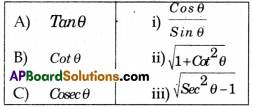

![]()
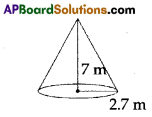

![]()
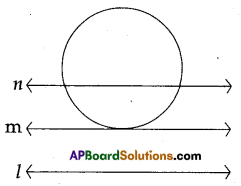

![]()
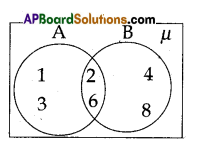
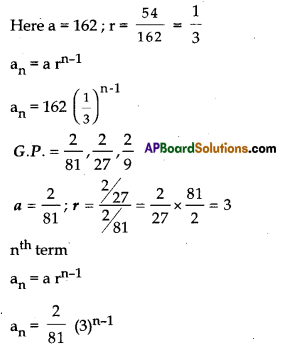
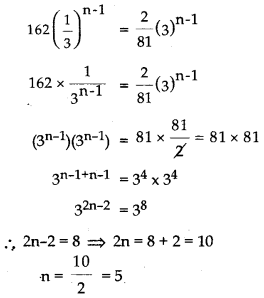


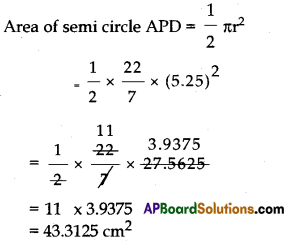
![]()
![]()

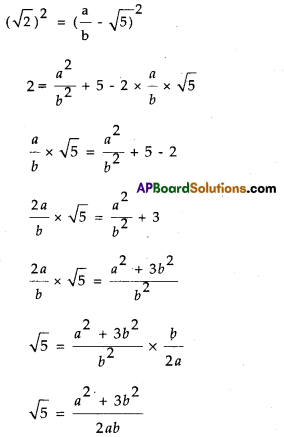
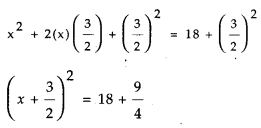
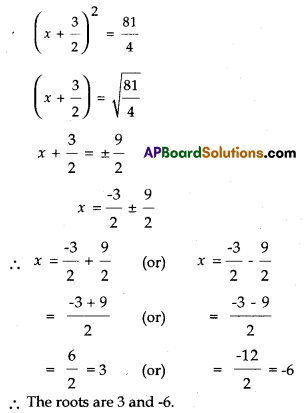

![]()
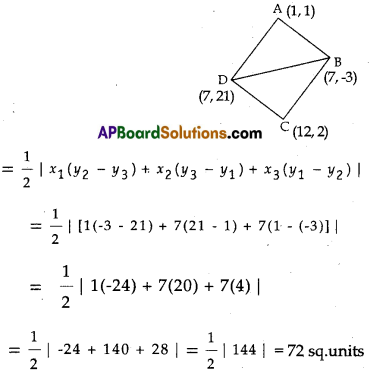
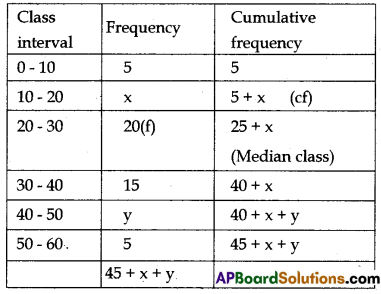
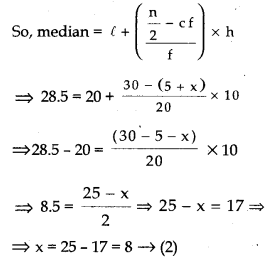

![]()

